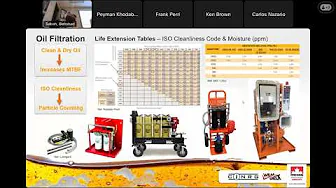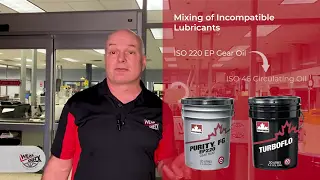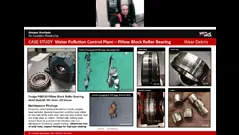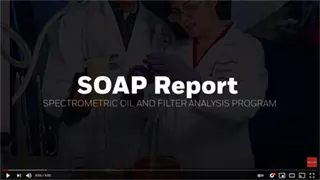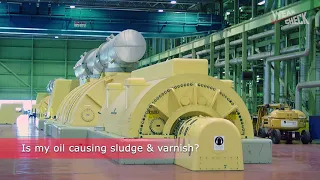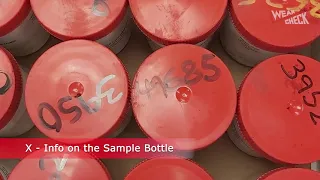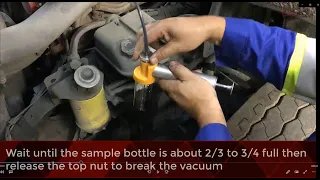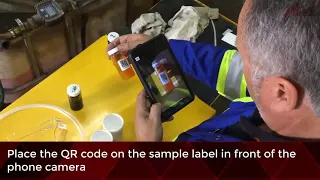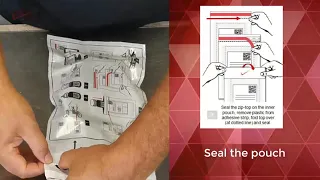Resources | All Resources
WearCheck Knowledge & Expertise
WearCheck has the benefit of a global network of industry knowledge leaders. The following resources are drawn from hundreds of years of their experience in the oil analysis industry. We hope you find these resources helpful in your understanding of oil analysis and provide you with an oil analysis program of increased value.
All Resources
Precision in every Drop - Powered by ICP Technology
Accurate and reliable analytical data is essential for effective decision making in today’s competitive industrial landscape, especially in the condition monitoring arena, which focuses on predictive maintenance. Elemental profiling using ICP-OES (Inductively Coupled Plasma - Optical Emission Spectroscopy) provides useful information on the chemical composition of lubricants. It can help track changes in specific additive profiles and contaminants that accumulate over time. Based on this data, it can be determined whether the oil remains suitable for use or if maintenance intervention is necessary. This Technical Bulletin highlights the principle, concept and methodology of WearCheck’s elemental analysis and how it is used to provide consistently reliable and accurate results.
Crude Awakening II - The Silent Architect
In a world constantly in motion, where ambition shapes empires and innovation fuels the future, there exists a silent force, unseen yet omnipresent. It threads through industries, binds economies, and lingers beneath every moment of modern life. It does not demand attention; rather, it works quietly, whispering beneath the hum of progress, woven seamlessly into the very foundation of civilisation. For generations, humanity has relied upon this force, stretching it to its limits, building entire industries upon its strength. It empowers nations, accelerates technological breakthroughs, and dictates the rhythm of history itself. And yet, despite its immeasurable influence, it remains overlooked, hidden in plain sight. What is this invisible force, this mysterious driver of the modern world?
Crude Awakening - The journey of crude: from ground to compound
Imagine, if you will, a humble, dark liquid pulled from deep within the Earth, mysterious, dense, and seemingly simple. Yet, in the right hands, this “black gold” holds the power to fuel your car, light up cities, and shape the products that make modern life possible. It may look like just a murky substance, but within it lies the potential for magic. This is where science meets alchemy, and engineering takes on the role of a wizard, transforming crude oil into petrol, jet fuel, and the very materials that power our world. Refining crude oil is not just a process; it’s a carefully orchestrated mystical journey, an intricate dance of heat, pressure, and precision that separates the raw from the refined. Ready to unravel the secrets behind this modern-day sorcery? Let’s take a deep dive into the fascinating transformation of crude oil into the everyday treasures upon which we all depend.
Sliding Through Time: Lubrication from stone age to modern age (Part 4 of 4)
In part three of Lubrication from Stone Age to Modern Age (Technical Bulletin 90), we glided through a mere 20 years of fascinating lubrication history and left off towards the final years of the roaring twenties.
Sliding Through Time: Lubrication from stone age to modern age (Part 3 of 4)
In part two of Lubrication from Stone Age to Modern Age (Technical Bulletin 89), we slid through 145 years of action-packed lubrication history and left off towards the end of the Gilded Age, full of hope and fuelled by endless technological possibilities. What was not to love? We had electricity, telephones, toasters, cars on the road, planes in the air and plenty of oil to lubricate the machines born of our wildest imagination.
Sliding Through Time: Lubrication from stone age to modern age (Part 2 of 4)
In part one of Lubrication from Stone Age to Modern Age, we slid through 5,000 years of lubrication history and left off at the end of the age of enlightenment in the early 1700s. The next leg of our journey finds us smack bang in the middle of the age of revolution, and a cascading series of events that led to the birth of the modern petroleum industry.
Ghost Particles - Particle Counting Methods and the Impact on ISO Cleanliness Codes
The new method for particle counting, ASTM D7647, solves a number of issues associated with optical particle counters, including effects from water and soft particles in the oil. Solvent selection is key to effectively mitigating these issues. This presentation on Ghost Particles discusses recent research by Petro-Canada Lubricants and CINRG Systems Inc that demonstrate the effects of the different solvents used on soft particles, including certain oil additives.
Sliding Through Time: Lubrication from stone age to modern age (Part 1 of 4)
From stone age to modern age, pharaohs to phenols, the history of lubrication is a story that demonstrates how a seemingly simple substance - oil - has propelled human progress, shaped industries, and ushered in a world of smoother operations and optimised performance.
An overview of 342 - Diesel quality and its importance.
SANS 342:2016 (South African National Standard) is the standard that governs the quality of diesel in South Africa. The SANS document, published by the South African Bureau of Standards (SABS) details the properties of diesel that are of importance, the tests that need to be carried out to determine quality, recommended test methods and the limits for the diesel to pass or fail the standard. Most of the test methods use the same specifications as ASTM (American Society of Testing and Materials), IP (Institute of Petroleum), ISO (International Standards Organisation) or SANS.
Ester-Gazers:Testing Guidlines for Natural Ester Oils in Transformers (Part 2)
Ester oil is a type of insulating oil used in electrical equipment. Natural esters are produced from vegetable oils such as rapeseed/canola. Synthetic esters are produced by the esterification of vegetable oils or animal fats. Esters are often blended with other chemicals to improve their properties. There are several advantages to using natural ester oil over traditional mineral oil, including: Less flammable: Ester oil has a much higher flashpoint and fire point than mineral oil, meaning it is less likely to ignite or burn. This makes it a safer option for use in electrical equipment located in areas where there is a risk of fire. Esters are biodegradable.High dielectric strength: Ester oil has a higher dielectric strength than mineral oil, meaning that it can withstand higher voltages without breaking down. It is more stable over a wider temperature range, making it suitable for use in a variety of climates. Superior moisture tolerance. No corrosive sulphur.
Ester-Gazers:Testing Guidlines for Natural Ester Oils in Transformers (Part 1)
Lubricants can be categorised in many different ways. One of the most common classifications is by the constituent base oil: mineral, synthetic or vegetable. Mineral oil, which is derived from crude oil, can be produced to provide a range of qualities associated with the oil’s refining process. Natural esters, derived from 100% renewable vegetable oils, are superior to mineral oil for use in distribution and power-generation transformers of all voltage classes, both new and retrofilled. In this Technical Bulletin, Corné Dames discusses the different condition monitoring options for the analysis of transformer component performance where natural esters are used as lubricants in transformers, to determine the degree of contamination by mineral oils and other substances.
Why WearCheck (Fleet Vehicles)
WearCheck not only helps reduce the cost to own/operate assets, but it also helps reduce the time and cost end-users spend to manage and run their oil analysis program. With the implementation of asset tags, QR SIF’s and online/remote sample submission, total costs for a high level condition based monitoring program can be greatly reduced. This brochure outlines some of the advantages of using the WearCheck oil analysis service.
Fleet Oil Analysis
Sales brochure on WearCheck's Fleet Oil Analysis Programs.
Construction Machinery Oil Analysis
Sales brochure on WearCheck's Construction Machinery Oil Analysis Programs.
When Smoke gets in your Eyes
Just Google ‘exhaust smoke’ and be prepared to sift through approximately 22,100,000 results (0,41 seconds) – an exhausting info overload. The author has been involved with trucks since 1966 and has never seen a driver fined for excessive exhaust smoke, or a truck owner taken to task for any abnormal emissions. And no wonder – the RTA regulations are so vague as to be unenforceable. It is not only the exhaust emissions we see (mainly due to particulate matter)that are cause for concern, but the ones we do not see – carbon monoxide and dioxide, nitrogen oxides, hydrocarbon particles and sulphur dioxide – which are truly dangerous.
WebCheck v2
[ English | Español | Française | Nederlands ]WebCheck v2, the new oil analysis management platform developed by the multidisciplinary team of experts at WearCheck International is an intuitive and simple platform that provides you with all the information, trends, and maintenance recommendations you need to keep your equipment in top condition. With a focus on reliability and efficiency, the WebCheck v2 platform takes your equipment maintenance to the next level, all from the comfort of your phone, tablet, or laptop.
Integrate Oil Analysis With Machine Data
Inflation and long lead times for new equipment are among the financial pressures pressing down on fleet managers to extend machine life. Pushing a machine too far results in loss of availability and utilization. A tried-and-true tool for machine health, oil analysis, has evolved with the advent of telematics to interact with machine data in a way that makes these decisions not only easier but also increases the odds that they will be successful. As a service, oil analysis has adapted to the new digital world to continue to provide value to the fleet asset manager. It is no longer enough to provide a web portal to manage oil analysis programs and view sample reports. Equipment-using organizations are expecting a tighter level of machine-data integration to drive higher levels of efficiency in all aspects of their business, and fleet maintenance is no exception.
Case Study: Distillery Decanter Centrifuge Bearing Reservoir
Bill Quesnel shares an interesting case study on a Decanter Centrifuge Bearing Reservoir at a distillery. In this video, Bill discusses how oil analysis was used to identify a potential issue with the bearing, which allowed the distillery to take corrective action before a catastrophic failure occurred. This case study highlights the power of predictive maintenance and the value of early detection. If you're interested in learning how oil analysis can help you optimize your maintenance program and improve equipment reliability.
When is the best time to start an oil analysis program?
Are you curious about when is the best time to start an oil analysis program? Gloria Gonzalez, the General Manager of WearCheck Canada, provides an insightful explanation. With her extensive experience in oil analysis, Gloria knows that early detection is key to minimizing equipment downtime and maximizing reliability.
Why Maintenance Planning and Scheduling may Fail (Part 2)
In this article, we discuss the six principles of maintenance scheduling and their importance to the maintenance function. Scheduling is sort of a direct response to Parkin’s Law (1955), which states that the amount of work assigned expands to fill the amount of time available. Visualise waking up without a to-do list on your day off from work - you might be able to do one or two tasks that day, but when you wake up with a list of five tasks, you might accomplish three or four of them. You might not be able to accomplish all five tasks on your list, but being able to complete three or four of them is far more of an achievement than just waking up without a plan and seeing how the day proceeds. Scheduling is all about goal setting, which involves giving enough work to craft crews to fill up a forecast of crew-work hours available - whether for a day or a week.
Why Maintenance Planning and Scheduling may Fail (Part 1)
This article discusses what causes maintenance planning and scheduling to fail to increase maintenance productivity, when at a casual glance, the framework of planning and scheduling seems to be in place in most industrial plants. The planning function and the scheduling function each have six principles, which, when applied in their correct sequence, ensure that the maintenance planning and scheduling process will be able to deliver its main objective – to increase maintenance productivity. The article starts with a discussion of the six principles of maintenance planning.
Assessing Oxidation Condition and Lubricant Refreshment in Turbine Oils
Turbines are critical pieces of equipment for power plants and related industries. Varnish formation is the first root cause for down time and loss of reliability in turbines. The lubricant’s oxidation condition can be effectively monitored through RULER (Remaining Useful Life Evaluation Routine), MPC (Membrane Patch Colorimetry) and RPVOT (Rotating Pressure Vessel Oxidation Test) tests. Besides the nominal ASTM (American Society for Testing and Materials) value for these tests, significant information can be gathered from digging into these tests and integrating their outcomes. One major application for this integration is the estimation of the lubricant refreshment for lean operation. Through lab tests, this can be accurately estimated, by planning ahead of the upcoming maintenance intervention. This method will be shown, together with case studies.
Dipstick Disasters and Loss Control
Say ‘dipstick’ and any driver’s mind flies towards an engine oil dipstick – especially older truck models that are not electronically equipped with sumplevel sensors and instrument panel signals. But modern trucks come standard with other fluid dipsticks as well, and that is where it all begins. A driver’s daily check sheet will include engine oil levels. But, unless the check is specific and limited to the engine only with training on how and when to read the dipstick, there is a danger that an ‘enthusiastic’ driver starts checking all the other dipstick levels that are best left to workshop technicians. Power steering, torque convertor automatic transmissions, and automated manual transmission (AMT) viscous couplings all require top-up techniques at operating temperatures with absolute cleanliness. Also, some systems - such as automatic gearboxes - require the lubricant level to be checked while the engine is running at idle.
Unpacking Vibration Analysis - a case study
During routine vibration data collection on a Boiler ID fan, it was noticed that severe structural vibration was emanating from the unit. Upon further visual inspection it was apparent that most of the base bolts were loose or completely missing. A request was raised by WearCheck to the relevant mechanical workshop to inspect the machine base of the Boiler ID fan and fasten/replace all bolts as required. This Technical Bulletin demonstrates the usefulness and accuracy of condition monitoring applications on a plant.
Talking Transformer Testing
Condition monitoring is the frequent collecting, measuring, recording, and analysis of the relevant data regarding an asset’s operation. If we interpret the data correctly, it can give us great insight into the asset’s condition. Frequent monitoring of the asset can result in less maintenance required or more extended periods without any maintenance required. It is crucial to identify the key parameters that are needed to give us a complete picture of the actual status of the transformer and the action we need to take to ensure the continued reliability of the asset to achieve the maximum lifetime.
Why WearCheck (Plant/Mill)
WearCheck not only helps reduce the cost to own/operate assets, but it also helps reduce the time and cost companies spend to manage and run their oil analysis program. With the implementation of asset tags, QR SIF’s and online/remote sample submission, total costs for a high-level condition-based monitoring program can be greatly reduced. Below are just a few of the advantages of using the WearCheck oil analysis service.
Why WearCheck (Construction/Mining)?
WearCheck not only helps reduce the cost to own/operate assets, it helps reduce the time and cost end-users spend to manage and run their oil analysis program. With the implementation of asset tags, QR SIF’s and online/remote sample submission, total costs for a high level condition based monitoring program can be greatly reduced. This brochure outlines some of the advantages of using the WearCheck oil analysis service.
Why WearCheck?
Why use WearCheck? WearCheck not only helps reduce the cost to own/operate assets, it helps reduce the time and cost end-users spend to manage and run their oil analysis program. With the implementation of asset tags, QR SIF’s and online/remote sample submission, total costs for a high level condition based monitoring program can be greatly reduced. This video highlights a few of the advantages of using the WearCheck oil analysis service.
The Future of Oil Analysis: Converting to Electric Power and Sensors
This article is from the STLE's TLT magazine, with contributions from Bill Quesnel of WearCheck Canada. With new technologies on the horizon, watching the oil analysis industry and planning for the future are key. Commercial oil analysis laboratories play a key role in the oil condition monitoring industry, but sensor technology and electrification have the potential to disrupt the status quo. Oil sensor technology is expanding, but high costs and low buy-in have prevented it from significantly displacing the role oil analysis laboratories play in the oil condition monitoring industry. Electrification, especially in the trucking industry, has a high potential to disrupt the oil condition monitoring industry because many commercial oil analysis laboratories focus on diesel engine testing.
Idling - Costly Fuel, Wear, and Engine-life Thief
Excessive idling is one of the most counter-productive facets of running a fleet of vehicles. In this Technical Bulletin, trucking expert Dave Scott discusses the effects of excessive idling and how to avoid it to minimise the negative consequences.
A New Perspective on Modern Day Maintenance (Part 2)
In this edition, I outline what several renowned maintenance practitioners believe is the best way to transition an organisation’s maintenance philosophy. Fundamentally, we do maintenance to achieve reliability, and, according to well-known author Ron Moore, ‘A reliable plant is a safe plant, is a profitable plant’. Profitability of any industrial plant is directly linked to its reliability, which in turn is determined by the quality of maintenance practiced. If we don’t maintain our assets, things can go terribly wrong. Almost all industrial disasters had poor maintenance reliability practices as one of the contributing causes.
Grease Analysis for Condition Monitoring
Traditional grease analysis involves testing to assess a grease products performance and quality. Employing today’s suite of new ASTM methods for lubricants, WearCheck has developed a range of grease testing programs to assess used greases and troubleshoot grease related lubrication issues. Bill Quesnel will discuss the various test methods employed for grease analysis in commercial oil analysis laboratories today and demonstrate the effectiveness of these new programs through a series of grease analysis case studies.
A New Perspective on Modern Day Maintenance
WearCheck provides thousands of customers each year with world-class condition monitoring (CM) services, which have been proven time and again to save time and money for companies by identifying potential machine failure before it happens and remedying the problem. However, in our line of work as condition monitoring (CM) specialists, we still do come across customers who have everything to gain by using the CM techniques we offer but, unfortunately, they don’t see the benefits to be gained. No matter how hard we try to convince them, they stubbornly continue to refuse help.
Biodiesel : A Complex Minefield
The subject of biofuel is vast and often controversial, and very topical right now as the world seeks more sustainable fuel sources. A practical and strategic approach to biodiesel is the thinking in what follows. Need, greed, legislation, climate change, deforestation, fake news, opportunism, ignorance, oil price, and a lack of long-term thinking all go into the melting pot of biofuel debates. Biofuels are energy sources made from recently-grown biomass (plant or animal matter). Biofuels have been around for a long time, but petroleum and coal have been used primarily as energy sources due to their high abundance, high energy value, and cheap prices. Fossil fuels such as coal and petroleum also come from biomass, but the difference is that they took millions of years to produce.
Thermal Fluid Analysis
Sales brochure on WearCheck's thermal fluid analysis program.
Diesel Emissions : A Breath of Fresh Air (Part 2)
We continue our discussion around reducing air pollution through stricter diesel engine emission standards and techniques. In this Technical Bulletin - the second of a two part series – we examine the intricacies of appropriate lubricant viscosity as well as the performance criteria of a range of additives and how they contribute to the war against harmful emissions, or not.
Diesel Emissions : A Breath of Fresh Air
As the world moves to adopt more planet-friendly strategies, air pollution is a key focus area for engine-manufacturers and operators. In this technical bulletin - the first of a two part series - global diesel engine emission standards are discussed, along with a range of techniques that reduce emissions, which ones are most effective, and why.
Honewell SOAP Report
The Honeywell Spectrometric Oil Analysis Program (SOAP) analysis report.
Varnish Testing by MPC
Membrane Patch Colorimetry (MPC) is a test that can determine the varnish potential of your oil by measuring the amount of insolubles present. Insolubles in oil eventually drop out of suspension and form sticky varnish and sludge in the system and on critical components which can lead to machine failure or outages.
How not to Submit Samples to the Laboratory
How not to submit samples to the laboratory","Common issues with samples submitted to the WearCheck laboratory are reviewed. Sample issues cause delays, and slow down the sample layout process. Please ensure that you are completing your sample forms, and properly packing your sample when sending them to the WearCheck laboratory.
ICP Analysis
An overview of Inductively-Couple Plasma (ICP) Spectroscopy or ICP Analysis which is a fundamental test in any oil analysis program.
How To Take Oil Samples from Fleet Machines
How to take oil samples from engines, transmission and hydraulic systems for fleet machinery
Submitting Samples with the Phone App
How to use the WearCheck Oil Analysis app to submit samples using an iOS or Android smart device (phone / tablet)
Submitting Samples to the Laboratory
How to properly prepare your samples for return to the WearCheck laboratory using the new QR-coded sample information forms and poly pack mailer.
Snake Oil : Promise vs. Performance
Choosing the correct lubricating oil, with or without additives, is critical to the smooth operation of machinery, however, there are many such products for sale which do not actually do what they claim to on the packaging label. As consumers, we need to be extra vigilant in ensuring that the oil we use complies with OEM specifications and indeed contains the additives that are advertised. Beware - what appears to be “cheap” oil (with false additive claims) (also known as “snake oil”) can lead to very expensive damage.
Navigating the Online Vibration Analysis Minefield
There is currently a notable spike in online installations in all industries, driven by Industry 4.0. This trend is also evident in the condit ion monitoring field. Installing online vibration transducers is a revolutionary step in the monitoring process but can be challenging without knowing what is available in the market and without a comprehensive understanding of the equipment capabilities and the relevant terminology. In this Technical Bulleting, we will guide you through the minefiled of available technology, discussing the different measuring capacities, installation levels and how these can be aligned with your requirements.
Submitting Adhoc Samples
Instructions on submitting adhoc fluid samples (samples submitted without WearCheck sample kits).
Industrial Oil Analysis
Sales brochure on WearCheck's Industrial Oil Analysis Prorgrams.
Transformer Analysis - How to take Samples
Instructions on taking syringe and bottle samples for transformer/insulating fluids.
Transformer Analysis - Using the Kit
Instructions on using the WearCheck Transformer Analysis syringe case and kit.
Transfomer Fluid Analysis
Sales brochure on WearCheck's transformer/insulating fluid analysis programs.
Using the Soft Mailer (Polypack)
Instructions on submitting fluid samples with the soft mailer (polypack).
Submitting Samples with the App
Instructions on using the WearCheck phone app to submit oil samples for mobile equipment.
Submitting Thermal Fluid Samples
Instructions and forms for submitting thermal/heat transfer fluid samples.
Oil Analysis Exposes Fleet Operational Challenges : Agricultural Industry
The challenge facing the agricultural industry is the need to meet high production targets for the agricultural season versus an unpredictable length (climate change impact) of the wet season. In some cases, this leads to the agricultural season starting off during wet weather, thus exposing the fleet to a considerable amount of operational risk.
MLT Training Course
Outline, schedule and registration information for the MLT Training Course.
Lube Hero Training Course
Outline, schedule and registration information for the Lube Hero Workshop.
Using QR Forms for Thermal Fluids
Instructions on using the pre-labelled QR forms with thermal/heat transfer fluids.
Options for Submitting Samples On-line
The various ways that you can submit oil samples using on-line tools.
The Engine Killers
I have a colleague who believes that engines don’t just simply die, they are murdered. A rather dramatic sentiment, I know, but then we take the death of an engine quite seriously at WearCheck. Being an avid consumer of forensics crime drama television series like CSI (Crime Scene Investigation) I feel that I can confidently explain the procedure that takes place once a murder victim has come to the attention of the authorities.
Reliability, Procurement and Spares Management
Effective asset optimisation plays a key rôle in boosting reliability as well as the efficient management of maintenance costs in any given operation. This Technical Bulletin discusses various scenarios in which maintenance costs can be reduced through improved procurement systems and better management of spares.
Sample/Fluid ID Tags
Sales brochure on WearCheck customized sample and fluid tags.
Keep it Clean
In today’s highly competitive global economy, the concept of machine reliability has led many an organisation to make the paradigm shift to proactive maintenance practices that take a holistic approach to asset management and contamination control. This focus on asset management and contamination control has highlighted the important rôle lubricants play in achieving machine reliability. Lubricants are no longer seen as merely consumables, but rather an integral part of a mechanical system having just as much merit as the componentry they lubricate and protect.
Condition-Based Assessment of On-Load Tap Changers
On-load tap changers (OLTCs) are a crucial element of utility networks, as they must operate in a precise fashion in order to maintain a constant voltage output. This must be achieved regardless of variation on input or load. OLTCs have been a weak link in many networks, as they deteriorate over time due to mechanical problems or contact wear from repeated operation. Erosion of the contacts over time is expected due to the nature of their function. Coking of the contacts causes overheating, which can cause thermal runaway. Regular maintenance is necessary to ensure continued proper functioning.
Wind Turbine Fluids Program
An overview of WearCheck's comprehensive fluids analysis programs for wind turbines (oil, grease, coolant, transformer fluid).
Wind Turbine Monitoring
Sales brochure on WearCheck's Oil Analysis Programs for wind turbines.
Maintenance Savings Sweeten the Sugar Industry
Case Study : Zambia Sugar. WearCheck’s oil analysis program is anchored in Zambia Sugar’s overall business strategy and entrenched in its overall vision and mission. WearCheck serves as a key stakeholder especially in the area of "Being worldclass and an efficient, low-cost producer, whilst achieving a balanced and integrated economic, social and environmental performance".
Elimination of Poisonous PCB Contamination in Electrical Equipment
PCB (polychlorinated biphenyl) is a highly toxic combination of molecules, which first came into existence in the late 1800s. The prevalence of PCBs mushroomed in the late 1920s as the technical benefits of the chemical compound were recognised and developed. Present day scientists, governments and businesses are tasked with eliminating PCBs as much as possible, due to their harmful, carcinogenic properties.
Measuring and Treating Varnish Formation in Turbine Oils
In this Technical Bulletin we discuss the treatment of varnish deposits in turbine oil, control valves and other machinery parts. We also look at what information can be gleaned from the varnish deposits, and how the data can be used to optimise turbine uptime and reduce maintenance costs. Laboratory test methods have now been developed to measure the varnish potential of turbine oils. The test method is colorimetric – it measures the total colour intensity of a patch to determine the varnish potential of the oil. It also can determine certain colour components of the patch which can help to pin-point the stress mode taking place in the oil that is leading to varnish formation.
CH4 can be Worth so much More (Part 1)
It is said that energy is the blood that runs through the veins of every economy. It is to the survival of an economy what water is to the survival of the human body. Without energy, the wheels of the economy literally do not turn. Energy is consequently a facilitator of economic development and stability. According to the South African department of energy (DoE), energy security within the South African context means ensuring that diverse energy resources, in sustainable quantities and at affordable prices, are available to the South African economy in support of economic development and poverty alleviation, taking into account environmental management requirements.
CH4 can be Worth so much More (Part 2)
In this final instalment, we will look at what oil analysis can measure in terms of the third function of oil analysis, which is to detect oil degradation. Oil is the lifeblood of any mechanical system and as such has many functions to perform. These functions can be categorised into four fundamental groups: reduction of wear, removal of contaminants, removal of heat and acting as a structural material. All these functions are negatively impacted if the oil physically or chemically degrades.
Using Oil Analysis to Monitor Your Lubrication Management Program
There is no question that an effective oil analysis program lowers maintenance costs on rotating equipment. The trick is knowing how to run an effective oil analysis program. Companies must be proactive, so that the solution to an oil-related problem is not always an oil change. The real benefit of oil analysis is using the data to steer you towards solutions to eliminate oil issues. Typical Internal Rates of Return (IRR) and Net Present Value over five years (NPV) for a lubrication management program in a medium sized plant are about 150% and $500,000. In this article, I will provide you with best practices for using oil analysis to monitor your lubrication management program.
World-Class Lubrication Management for Gearboxes
As the saying goes, "an ounce of prevention is worth a pound of cure." When it comes to maintenance of your plant's gearboxes, this is definitely true. By using an industry-leading Lubrigard gearbox adapter kit to perform regular maintenance, a company will save money and time, reduce operating costs and have longer-lasting, more reliable equipment. For an average $600 investment, a company can protect an $80,000 piece of equipment.
Terms & Conditions
Standard terms and conditions for WearCheck's services.
Mobile Oil Analysis
Sales brochure on WearCheck's Mobile Oil Analysis Programs.
Advanced Oil Monitoring (AOM)
Sales brochure on Advanced Oil Monitoring (AOM) for turbines and industrial compressors.
Holistic Diagnosis
Anyone reading this technical bulletin will be familiar with the condition monitoring technique of oil analysis. A small sample of oil is drawn from a lubricated piece of machinery and analysed for the presence of wear debris and contaminants, as well as an assessment of the health of the oil itself. So far, so good, the oil (or grease) can be subject to a whole battery of physical and chemical tests which, in turn, can provide upward of 50 (in the case of a fully comprehensive analysis) different parameters that need to be assessed in order to determine the health of the machine, the health of the oil and the levels of contamination.
Talking Turbine Testing
This Technical Bulletin discusses a variety of turbine sample tests - how they are conducted, and what information they provide. The test results enable the best remedial action to be taken for the component in question, in turn boosting the reliability of the turbine by maintaining the oil - which is often a large financial investment - in peak operating condition.
Reaping the Renewable Whirlwind
The estimated life span of wind turbines is about 20 years, compared to conventional steam turbine generator units that have averaged 40 years. The failure rate of wind turbines is about three times higher than that of conventional generators and this has historically been attributed to constantly changing loads experienced by the wind turbine as a result of environmental variants. Due to these highly variable operational conditions the mechanical stress placed on wind turbines is incomparable in any other form of power generation and they consequently require a high degree of maintenance to provide cost effective and reliable power output throughout their expected 20 year life cycle. The wind turbine gearbox is the most critical component in terms of high failure rates and down time.
Oil - An Asset, Not a Consumable
The days of "oil is oil" have long gone. It is vitally important that in this day and age, oil needs to be considered as an asset rather than just a consumable, and as an asset, it needs to be managed. This brief paper will take a look at how oils are selected and then managed throughout the plant as a valuable asset like any other piece of industrial equipment.
Acids and Bases, the "Spy vs. Spy" of the Lubrication Game
In many ways, the properties of acids and bases are embodied by the classic cartoon strip, “Spy vs. Spy”, which was fi rst published in Mad Magazine in 1961. This Technical Bulletin will help you understand what acids and bases are all about, why they need to be assessed, methods of assessment and what these parameters have to do with industrial and mobile equipment. If the amount of acid or base present in your oil is unfavourable, then the oil – or more critically, the machine – can be damaged. It is thus essential to understand these terms with reference to oil analysis in order to get the best life from your assets by reducing downtime and minimising costly repairs.
SOS : Sources of Silicon
Oil analysis is a well-established condition monitoring technique that has been with us since the late 1940s. It originally developed from a need to monitor main bearing wear in locomotive engines in the United States by spectrometrically measuring the amount of lead in the engine oil. Oil analysis has come a very long way in the last 60 years with the introduction of a whole range of tests that include acid and base numbers, particle counting, infra-red spectroscopy, viscosity, water and fuel contamination and many, many more. However, spectrometric analysis still remains at the core of any oil analysis programme and provides the greatest amount of information in the shortest possible time and at the lowest cost.
Liquid Chromatography and it`s Application in Transformer Oil Analysis
The laboratories of condition monitoring specialists WearCheck are equipped to monitor oil and fluids from a wide array of industrial machinery, including transformer oil, utilising a number of sophisticated analytical techniques, one of which is the focus of this Technical Bulletin. Before I get into the liquid chromatography technique, I would like to briefly cover what it is we would use this technique for, and why.
Solids, Liquids and Gases
In this bulletin we discuss solids, liquids and gases and how they relate to dirt, water and air – three of the most common contaminants found in oil. We look at what they are, what causes them, what damage they do, how we detect them and how to prevent them from causing problems.
How do Oils Degrade?
Oils have a finite lifetime - they will eventually degrade and/or become contaminated and will need to be changed. Lubricants consist of a base stock that can either be mineral or synthetic. In the case of synthetic base stocks, these are a family of compounds that are manufactured in a laboratory to have precisely the properties that the chemists and engineers want. Mineral base stocks are derived from crude oil that comes out of the ground and is refi ned to produce a base stock that can do the desired job. Synthetic bases are superior to mineral ones but are much more expensive.
The Month End Report - A Wealth of Valuable and Useful Information
The month end or management report contains a wealth of very valuable and useful information. It comprises a statistical distillation of the previous month’s samples and compares these data to the previous twelve months. Analyses include a variety of parameters that will give the customer a good idea of how effective their oil analysis programme is and where the problem areas lie in terms of what the problems are, what components are affected and how severe the problems are.
Driven to Detect Deterioration
What do the results mean? This is a very common question asked of the diagnosticians at WearCheck. The answer to this is to read the diagnosis because this is the distillation of all the inputs that the company receives. What the diagnostics department does every day as a service to customers, diagnosing sample results, comes easily when there are years of experience at hand and the diagnostic processes are designed in-house to streamline what could be a difficult, highly complex and time-consuming job. This diagnostic process is underpinned with many very sophisticated software systems that have all been specified by the department and written in-house. These processes run in the background and ensure that the diagnosis is made timeously, accurately and efficiently. This bulletin will shed some light on how the diagnostics department takes the multitude of information attached to each sample and uses it to supply the customer with a meaningful diagnosis.
Limits - the Robots of Oil Analysis
Questions on limits on oil analysis parameters, such as wear levels, additive levels and viscosity are high on the list of those that the WearCheck diagnosticians field most often. “When is the iron too high?”, “how much viscosity increase is acceptable?” and so on and so forth. Unfortunately, there are not always hard and fast answers to these questions; in fact there are seldom such answers.
The Best Oil Analysis Programs Start with a Good Sample
The accuracy of analysis of an oil sample is greatly influenced by two aspects of the whole procedure the customer controls: how the sample is taken and the information accompanying the sample. The latter has been dealt with in previous technical bulletins. The taking of an oil sample is where the whole analytical process begins. All the sophisticated oil analysis tools, techniques and diagnostic processes are meaningless if the oil sample fails to represent the actual condition of the oil in service in the machine.
Base Stocks & Additives - How oils are formulated
There are tens of thousands of different lubricants on the market, from simple hydraulic fluids to very sophisticated synthetic oils formulated for high performance engines. Think of the technology that is required to lubricate a formula one racing car; after the race the team is more likely to change the engine than the oil!
Where does all that Metal come From?
Oil analysis involves the extract ion of a small, representative sample of oil from a lubricated piece of machinery and subjecting it to a whole battery of chemical and physical tests in a laboratory. The data is then interpreted to produce a report. There are three fundamental areas of interest in an oil analysis report: the health of the machine being sampled, the health of the oil lubricating that machine and the levels of contamination.
Return Policy
WearCheck's return policy for sample kits and Lubrigard products.
Varnish Potential (MPC)Testing
An overview of Membrane Patch Colorimetry (MPC) testing for varnish potential in oils.
Submitting Honeywell SOAP Samples
Instructions on remitting Honeywell Oil & Filter (SOAP) Samples.
Predicting the Remaining Useful Life of Your Lubricant
Lubricants do not last forever - a statement well understood by lubricant users all over the world. They are susceptible to the ageing process like most things on earth. An example of the aging process that is witnessed by everyone is the human skin. It ages with time and degrades by a process known as oxidation. Lubricants are no exception. Oxidation is currently being accepted as the major cause of lubricant ageing/degradation.
Analytical Ferrography
A tech doc providing an overview of Analytical Ferrography (wear particle analysis).
The Effects of Temperature on Engine Lubricating Oil
The effect of temperature on engine lubricating oil is an important consideration to take into account when operating a large fleet of vehicles. Except for electrically powered units, all vehicles are powered by a combustion engine of some description, be it fuelled by gas, petrol or diesel.
The Low-down on Lower Emissions array(Part 1)
The automotive industry in South Africa is largely focused at the moment on lowering vehicle exhaust emissions. This follows a global movement towards more stringent air emission control laws in man’s attempt to slow down the destruction of our planet through global warming. So what is all the hype about? A basic understanding of the fundamentals of global warming in terms of the greenhouse effect is needed in order to understand the advances the automotive industry is implementing to combat dangerous exhaust emissions.
The Low-down on Lower Emissions array(Part 2)
It was seen in the last Technical Bulletin that, in order to reduce our effect on the environment due to harmful vehicular exhaust emissions, we need to ensure a reduction of the emissions. This is now reality due to the new laws being implemented around the world. So what is being done to ensure this happens and what part do we, as the consumer and concerned citizen, play in all this?
Analysing Used Oil....What are the Benefits?
In a recent meeting we were discussing what the topic for the next technical bulletin should be. After writing technical bulletins for fifteen years it suddenly dawned on me that we have never written a bulletin outlining the benefits of performing used oil analysis. I have written brochures and I can find at least two dozen PowerPoint presentations that address this question but the material has never ended up in this format. So, without further ado, what are the benefits of a well-run oil analysis programme?
If you can`t stand the Heat...
Earlier this year we published a Technical Bulletin on the ups and downs of viscosity. This was an important topic to cover as the viscosity of an oil is its most fundamentally important property. Both physical and chemical degradation can cause a change in the viscosity of an oil and, in terms of an increase in viscosity, poor combustion and sludging have been covered extensively in a number of Technical Bulletins. This Technical Bulletin will deal with high temperature operation and the effect it has on the rate of oxidation and, in turn, the degradation of lubricating oils and consequent increase in their viscosity.
The Ups and Downs of Viscosity
The topic of viscosity has been covered extensively in many technical bulletins and with good reason. The viscosity of a lubricant is its most important physical property and it is this property that defines the very essence of the oil. Viscosity grading systems such as the SAE (Society of Automotive Engineers) for automotive oils and the ISO (International Standards Organisation) for industrial applications have received universal acceptance as a means of classifying lubricants.
Transformer Oil Analysis
It is well known that regular oil analysis is extremely useful in monitoring the condition of engines, drivetrains, hydraulics, turbines and many other types of oil lubricated equipment. The same can be said for transformer oils which are used to insulate many transformers and other electrical distribution equipment. The analysis of transformer oils not only provides information about the oil, but also enables the detection of other potential problems, including contact arcing, ageing insulating paper and other latent faults and is an indispensable part of a cost efficient electrical maintenance programme.
Why Cheap Oil Analysis Might be More Expensive
Wearcheck provides its customers with a wide range of tests that cover most problems encountered in most types of equipment in most types of environments and applications. There are obviously a range of tests that some of our clients would like us to do but are cost prohibitive. Laboratory equipment, like earthmoving equipment, is expensive and we too have a weak Rand working against us. It is very difficult to justify spending a million Rand on a laboratory instrument if we are only going to use it for a few tests per month, and customers would not be prepared to pay a couple of thousand per sample in order to make the equipment pay for itself. Having said that, every effort is made to outsource tests that we cannot do.
Clean Oil Saves Money
In our current economic age, companies are forced to pursue every avenue for cost saving to ensure that their chance of financial success is maximised. Lubricated mechanical equipment is a significant cost to many companies and, through careful management, significant savings can be achieved. This technical bulletin looks at particle counting, explains the jargon and technology, and shows you how by monitoring your oil’s cleanliness you can reduce repairs, maintenance costs and downtime and save on your bottom line.
Why Oil Analysis Programs Sometimes Fail
Before looking at the effective management of oil analysis programmes it is salutary to look first at the reason why these programmes sometimes do not work. The service provider is frequently blamed for the failure of a doomed oil analysis programme when the fault almost always lies with the end user. This is generally not as a result of poor management but a lack of education and understanding.
Dirty Diesel
Although not an issue in terms of contamination, sulphur is an area of concern. There is a range of valid reasons for the removal of sulphur from our diesel supplies. The first most pressing reason is that high sulphur diesels produce sulphur oxides on combustion which, when dissolved in the other by-product of combustion – water - form strong acids. When these acids condense they attack the metal surfaces of valve guides, cylinder liners and bearings. The acids produced are neutralised by the engine lubricant and, in doing so, reduce the working life of the lubricant necessitating shorter drain intervals.
How to calculate the effect Oil Analysis has on the Bottom Line
Over the last ten years there has been a paradigm shift that has seen maintenance become almost synonymous with achieving reliability. Let"s start by looking at a few definitions.
The humble sub-form is the linchpin of oil analysis array(Part 1)
In countless articles, seminars, training courses and technical bulletins it has been stressed that there are two main reasons for an oil analysis programme to fail. The first is that the oil sample is not representative of the oil in the system, in other words, the dreaded ‘bad sample’. The second involves information regarding the sample. This can either be wrong or, quite simply, missing. In the majority of cases it is the second reason that causes the most problems, not just in terms of the diagnosis but for data processing and the laboratory.
The humble sub-form is the linchpin of oil analysis array(Part 2)
This is the second part of the article on how to submit a submission form and what can go wrong if any information is missing or incorrect. This is vitally important considering that 20% of all samples are submitted to Wearcheck with incorrect or insufficient details, causing costly delays and hampering accurate diagnosis. An example of a submission form appears on page 3.
We are ready for more soot
Get Ready for More Soot’ is the title of an article written by Drew Troyer of the Noria Corporation for publication in Practising Oil Analysis. It deals in part with the effect that current and proposed environmental legislation would have on the performance of engine lubricants. This Technical Bulletin takes a close look at soot, why it is a problem, why is it becoming more of a problem and how to measure its presence in oil.
Why are there so many oils?
There is a common misconception that ‘oil is just oil’ and this simply is not the case. Consider the many types of machines that need lubrication and that these machines can operate in many different environments doing many different jobs. There are also dozens of different oil suppliers who can supply thousands of different oils based on viscosity and additive chemistry which dictate their function. This is why there is such a variety of oils in the market place. This technical bulletin will look at the different classes of oils (liquid lubricants) and why they are different.
Keep your cool array(Managing Cooling Systems)
During operation, all internal combustion engines produce heat as a by-product of combustion. The temperature of burning fuel can reach 2000°C. However, only about 33% of this is transferred into power through the crankshaft. Approximately 30% is expelled through the exhaust whilst another 7% or so is lost through radiation. The remaining 30% must be dissipated through a cooling system. In addition to removing heat from burnt fuel, the cooling system also removes heat from other sources such as turbochargers, torque converters and hydraulic or transmission oil coolers.
Detecting Particles in Oil (Part 1)
In simple terms, monitoring wear particles in used oil samples from plant and equipment enables specialists to decide whether they are normal or abnormal and what the likely consequences will be for the machine. In real terms, this is a fairly complicated process. This technical bulletin outlines some of the techniques used in Wearcheck"s oil analysis laboratories to detect and quantify particle contamination, and discusses the value and limitations of these methods in detecting abnormal wear situations.
Detecting Particles in Oil (Part 2)
In the last technical bulletin we looked at four of the seven techniques used in Wearcheck"s oil analysis laboratories to detect and quantify particle contamination, as well as the value and limitations of these methods in detecting abnormal wear situations. In this issue we examine the remaining three techniques.
How does Oil Work?
Friction is a ubiquitous part of our daily lives. Walking, writing, opening doors and drawers and driving to work all involve energy being expended in order to overcome friction. Although friction is generally thought of as a negative mechanical characteristic (approximately 20% of a car"s energy is spent in overcoming friction) it must be remembered that without it we would not be able to walk and the brakes on our cars would not work.
Aviation Analysis
Sales brochure on WearCheck's programs for aircraft and aviation components.
The Perils, Pitfalls and Perks of extending oil drain periods
The extension of oil drain periods has long been an area of debate. There are many benefits to be obtained from extending oil drain periods and doing so is a legal requirement in certain countries around the world. These benefits are just as applicable to South Africa but it would be foolish to try to apply parameters recommended for European, Japanese or North American conditions (the source of most diesel engine technology) to this country.
Clean up your act
It is widely accepted that oil contamination is the one of the major causes of component failure. When practising proactive maintenance it therefore makes sense to give oil cleanliness a high priority. This technical bulletin will deal primarily with particulate contamination, the causes, and how to avoid it. By maintaining a high level of oil cleanliness, machinery failure, resultant downtime and expensive repair costs can be kept to a minimum.
Greek for beginners (part2) - or the tests and what they tell us
In the last Technical Bulletin we looked at the four tests which every sample receives. We now take a look at tests specific to various sample test classes, and extra tests which are triggered in extraordinary circumstances.
Engine Troubleshooting Checklist
Air intake system check; Air cleaner element holed or not sealing correctly; Incorrect size air cleaner element for type of housing.
Drivetrain Components Troubleshooting Checklist
Abnormal Wear/Debris Checks; Check magnetic drain plug for particles and examine; Check magnetic screens.
Greek for beginners (part1) - or the tests and what they tell us
Two of the most common questions Wearcheck"s diagnosticians are asked are: "What tests do you do?" and "How do I interpret the results?" The first question is easy to answer, the second not quite so. In addition to their formal academic instruction, all Wearcheck diagnosticians undergo a six month internal training programme before they get their wings. During this time they diagnose twenty-five to thirty thousand samples, each of which is vetted by a qualified diagnostician before being accepted. The reasons for this are that the tests are so inter-related and mutually dependent that interpretation of the results is not always straightforward. Knowing this it is easy to appreciate the impossibility of putting the whole process of diagnosis into a few lines.
Monitoring Oil Degradation with Infrared Spectroscopy
What is infrared? This thing that allows us to "see" in the dark, helps secure our homes, allows those couch potatoes amongst us to change the channel on the TV without leaving our seats and, in our case, monitor oil degradation. To answer this we need to take a look at the electromagnetic spectrum. To many, the electromagnetic spectrum is a formidable subject, yet to the analytical chemist it is a tool so useful it is without comparison. The electromagnetic spectrum is made up of electromagnetic waves. These are waves of energy that have both an electrical and magnetic component. These waves all travel at the same velocity - the speed of light (approximately 299 792 km per second) but their properties are determined by their frequency and wavelength.
Sludge
Sludge (noun) : Thick, greasy mud; sewage; muddy or slushy sediment or deposit; accumulation of dirty oil, esp. in sump of internal combustion engine. This is how the Oxford English Dictionary defines sludge and it is a very accurate description of what is found in the sumps of internal combustion engines. In this case, sludge is a collection of resins, lacquers, combustion by-products, oil degradation by-products, water, dirt and wear metals. However, to the tribologist and the mechanical engineer there is a more specific definition for the word sludge: fuel soot, a combustion by-product. This can lead to come confusion as the two definitions are frequently used interchangeably.
Implementing Reliability-Centered Maintenance (RCM)
Using RCM to develop an initial maintenance program for new equipment as well as scheduled maintenance for existing plant, involves a structured decision-making process based on the consequences of functional failure of this equipment. RCM analysis produces a program which includes all scheduled tasks - and only those tasks - necessary to ensure safety and operating economy. The decision-making logic behind RCM analysis applies to any complex equipment which requires a maintenance support program aimed at maximizing operating reliability at the lowest cost.
Condition-Monitoring, Oil Analysis & More
In this day and age, predictive maintenance and condition monitoring are necessities for any company that has machinery which is critical in achieving production goals. Oil analysis is a condition monitoring technique that has been in use for more than 50 years and has proved to be a highly effective management tool for monitoring the health of lubricated machinery and the lubricants themselves. However, oil analysis is not the only condition monitoring technique available to today"s maintenance professional. Other techniques such as vibration monitoring, thermography and ultra-sonic analysis can also be used. This Technical Bulletin will look at the evolution of maintenance philosophies, the goals of a condition monitoring programme and how a combination of different analytical practices can be used to achieve these goals.
On-Site Analysis - Blessing or Burden?
The concept of on-site analysis (OSA) - a company setting up a small laboratory on its premises where it performs its own oil analysis instead of contracting it out to a specialised external oil analysis laboratory - has been around for many years. The sort of organisations that have opted for OSA are usually large operations in out of the way places such as mines where transporting oil samples is difficult and time-consuming, or where security considerations create problems such as on diamond mines.
Your Questions Answered (FAQ for Oil Analysis Laboratories)
Wearcheck technical staff are always happy to answer queries from customers to help them get the most from their oil analysis programme. For the benefit of all Wearcheck customers, we have put together the most commonly asked questions and feature them, along with the answers, in this technical bulletin.
What is RPD ferrography?
Oil analysis, including ferrography, provides the greatest value for money of any maintenance monitoring technique. While most maintenance managers are familiar with the general concept of oil analysis, ferrography is less understood. This Technical Bulletin describes how ferrography fits into the overall oil analysis picture, with particularly emphasis on RPD (rotary particle deposition) ferrography and how it can be integrated into a maintenance programme to achieve substantial financial benefits at relatively low cost.
Oil pressure mapping to measure bearing wear
One of the current buzzwords being used in condition monitoring is oil pressure mapping. This technical bulletin explains oil pressure mapping, why this diagnostic technique was developed and how it is used to measure engine bearing wear.
Wear limits versus trends
Common questions asked by people using oil analysis are `What wear limits do you use?", "What levels are normal?", and "What levels are abnormal?" These are not unreasonable questions. A number of OEM"s (original equipment manufacturers) do have wear limits for their equipment but unfortunately they are not an effective means of determining the health of a component. The levels of contamination and particularly wear debris in an oil sample are dependent on too many factors for an equipment manufacturer to set out nice, neat wear tables that say, for example, 0 - 50 is okay, 50 - 100 indicates a problem, and over 100 is very serious. This runs the risk of saying that 49 `whatevers" is acceptable and 51 is not when, in this case, there is only a difference of 4%.
Debris Analysis
The wear readings traditionally encountered in oil analysis are expressed as a percentage, or more commonly as PPM (parts per million) with 1 PPM being equal to 1/10000th of 1% (eg. Fe = 100 PPM). These concentrations are measured with a spectrometer, in Wearcheck’s case an ICP (Inductively Coupled Plasma) spectrometer. There is a fundamental limitation to measuring the concentration of wear debris with this technique. Because of the way that these instruments work, particles greater than 8 - 10 m (micron) cannot be detected. It is obvious that a critical wear situation could exist with large particles present but the iron concentration might be low, i.e. most of the wear particles are greater than 10 m in size and would not be picked up by the spectrometer.
How to get the most out of your Oil Analysis Program
The effectiveness of an oil analysis program is significantly affected by how well maintenance staff understand the program and by the quality of their input to WearCheck. This bulletin gives an insight into the different factors which can influence the effectiveness of oil analysis and so help companies get the best results from their program.
Reliability-Centered Maintenance
Maintenance philosophies and practices have been around for many years - the objective of these philosophies being the economic consideration of optimizing plant availability in industry. There has been a steady evolution from breakdown maintenance to predictive maintenance to proactive maintenance in the quest to keep industrial equipment operating economically, efficiently and safely.
How to Read a Can of Oil (Part 1)
When purchasing a can, drum or tankerful of oil, it is important to realize that a number of international classification systems are used to describe the product and its uses. The classifications, which include ISO, SAE, API, CCMC, SABS, JAMA and ISLS, are each followed by a series of numbers and letters detailing either the viscosity of the oil or its performance properties. This bulletin will examine viscosity classification while the performance characteristics of oil will be covered in a later issue.
How to Read a Can of Oil (Part 2)
In part one of "How to read a can of oil", the focus was on the viscosity classification systems of lubricants, namely the International Standards Organisation (ISO) system for industrial lubricants and the Society of Automotive Engineers (SAE) system for automotive oils. This technical bulletin will concentrate on the performance specifications of oils, addressing the following questions: What can I use this oil for? Which oil is suitable for the different types of equipment? Is one product better than another?
An Introduction to Synthetic Oils
Synthetic lubricants are a product of the trend towards increasingly complex industrial and automotive equipment designed to meet ever more severe operating conditions - such as extremes of temperature in the operating cycle, the need for sealed-for-life components or extended overhaul periods. In these cases the equipment has exceeded the performance capabilities of conventional mineral oil based lubricants, and created the need to develop synthetic oils.
Infrared Analysis as a Tool for Assessing Degradation in Used Engine Lubricants
The use of infrared spectroscopy for routine monitoring of oil-lubricated components, breakdown products and contaminants has not been widely used in the past, although infrared studies of lubrication oils themselves have been performed for a number of years. The reason for this is that older dispersive infrared spectrometers would take several minutes to generate a spectrum of the used oil and then considerable additional time would be needed to reduce and interpret spectral data.
Direct Reading and Analytical Ferrography
According to Webster’s dictionary tribology is "the study of lubrication", and comes from the Greek tribein, which means "to rub". When two components in a lubricated system rub, wear particles are generated. Contrary to what you might think, wear particles do not come in all sizes and shapes. There are, in fact, only a handful of distinct types of wear particles, and these particles occur in only specific size ranges. The most common wear particle in a lubricated system is the normal rubbing wear particle.
Oxidation and Oxi-polymerization of Oils
Degradation of oils in service is an inherent part of their use. The rate at which oils degrade is dependent on several factors including the chemistry of the oil basestock, the type and amount of various inhibitors, and additives present in the oil, and the operating conditions of the oil over its service life. The main factors that attribute to the extended life of an oil in service are its thermal and oxidative stability. Thermal stability represents the oils ability to resist chemical change with increasing temperature in the absence of oxygen. Oxidation stability is the oils ability to resist chemical change, typically with increasing temperature, in the presence of oxygen.
Laboratories at Work: Used Oil Analysis at WearCheck Belgium
Used oil analysis is comparable to a medical analysis with a blood test. Like blood, lubricating oil contains a good deal of information about the envelope in which it circulates. Wear of metallic parts, for example, produces a lot of minute particles, which are carried by the lubricant. These small metal particles can give information about the machine elements that are wearing, and can be detected by various methods, for example, Atomic Emission Spectrometry. Determination of larger particles can be done using optical or electronic microscopy, or ferrography.
Silicon....enemy number one
After oxygen, silicon is the most abundant element in the earth"s crust. Silicon does not occur naturally in elemental form but rather combined with oxygen in a compound called silica (silicon dioxide). Silica occurs in a free form (quartz, sand, etc.) or combined with a variety of metallic oxides, in which case it is called a silicate (eg. Felspar). Another class of silicon compounds that should not be confused with silica and silicates is silicones. Silicones are man-made organic compounds that find extensive application in the polish, paint and lubrication industries.
Particle Counting and Contamination Analysis in Fluid Power Systems
Typically most oil analysis companies have relied on spectrometric and debris analysis for the detection of wear particles and contaminants in the oil lubricated components. The ICP (inductively coupled plasm) spectrometer used by WearCheck is limited to a maximum particle size of eight microns that it can detect, so other techniques must be employed to detect larger wear particles and contaminants. The ideal situation would be to filter all oil samples and examine any debris under a microscope; this is highly labour intensive in terms of sample preparation and visual analysis of the debris and only provides a qualitative description of the debris.
All Resources Categories
Resource Categories
Accurate and reliable analytical data is essential for effective decision making in today’s competitive industrial landscape, especially in the condition monitoring arena, which focuses on predictive maintenance. Elemental profiling using ICP-OES (Inductively Coupled Plasma - Optical Emission Spectroscopy) provides useful information on the chemical composition of lubricants. It can help track changes in specific additive profiles and contaminants that accumulate over time. Based on this data, it can be determined whether the oil remains suitable for use or if maintenance intervention is necessary. This Technical Bulletin highlights the principle, concept and methodology of WearCheck’s elemental analysis and how it is used to provide consistently reliable and accurate results.

Sharista Raghunath
WearCheck Africa
In a world constantly in motion, where ambition shapes empires and innovation fuels the future, there exists a silent force, unseen yet omnipresent. It threads through industries, binds economies, and lingers beneath every moment of modern life. It does not demand attention; rather, it works quietly, whispering beneath the hum of progress, woven seamlessly into the very foundation of civilisation. For generations, humanity has relied upon this force, stretching it to its limits, building entire industries upon its strength. It empowers nations, accelerates technological breakthroughs, and dictates the rhythm of history itself. And yet, despite its immeasurable influence, it remains overlooked, hidden in plain sight. What is this invisible force, this mysterious driver of the modern world?

Rivendren Wayne Moodley
WearCheck Africa
Imagine, if you will, a humble, dark liquid pulled from deep within the Earth, mysterious, dense, and seemingly simple. Yet, in the right hands, this “black gold” holds the power to fuel your car, light up cities, and shape the products that make modern life possible. It may look like just a murky substance, but within it lies the potential for magic. This is where science meets alchemy, and engineering takes on the role of a wizard, transforming crude oil into petrol, jet fuel, and the very materials that power our world. Refining crude oil is not just a process; it’s a carefully orchestrated mystical journey, an intricate dance of heat, pressure, and precision that separates the raw from the refined. Ready to unravel the secrets behind this modern-day sorcery? Let’s take a deep dive into the fascinating transformation of crude oil into the everyday treasures upon which we all depend.

Rivendren Wayne Moodley
WearCheck Africa
In part three of Lubrication from Stone Age to Modern Age (Technical Bulletin 90), we glided through a mere 20 years of fascinating lubrication history and left off towards the final years of the roaring twenties.

Steven Lara-Lee Lumley
WearCheck Africa
In part two of Lubrication from Stone Age to Modern Age (Technical Bulletin 89), we slid through 145 years of action-packed lubrication history and left off towards the end of the Gilded Age, full of hope and fuelled by endless technological possibilities. What was not to love? We had electricity, telephones, toasters, cars on the road, planes in the air and plenty of oil to lubricate the machines born of our wildest imagination.

Steven Lara-Lee Lumley
WearCheck Africa
In part one of Lubrication from Stone Age to Modern Age, we slid through 5,000 years of lubrication history and left off at the end of the age of enlightenment in the early 1700s. The next leg of our journey finds us smack bang in the middle of the age of revolution, and a cascading series of events that led to the birth of the modern petroleum industry.

Steven Lara-Lee Lumley
WearCheck Africa
The new method for particle counting, ASTM D7647, solves a number of issues associated with optical particle counters, including effects from water and soft particles in the oil. Solvent selection is key to effectively mitigating these issues. This presentation on Ghost Particles discusses recent research by Petro-Canada Lubricants and CINRG Systems Inc that demonstrate the effects of the different solvents used on soft particles, including certain oil additives.

Bill Quesnel
WearCheck Canada
From stone age to modern age, pharaohs to phenols, the history of lubrication is a story that demonstrates how a seemingly simple substance - oil - has propelled human progress, shaped industries, and ushered in a world of smoother operations and optimised performance.

Steven Lara-Lee Lumley
WearCheck Africa
SANS 342:2016 (South African National Standard) is the standard that governs the quality of diesel in South Africa. The SANS document, published by the South African Bureau of Standards (SABS) details the properties of diesel that are of importance, the tests that need to be carried out to determine quality, recommended test methods and the limits for the diesel to pass or fail the standard. Most of the test methods use the same specifications as ASTM (American Society of Testing and Materials), IP (Institute of Petroleum), ISO (International Standards Organisation) or SANS.

John Evans
WearCheck Africa
Ester oil is a type of insulating oil used in electrical equipment. Natural esters are produced from vegetable oils such as rapeseed/canola. Synthetic esters are produced by the esterification of vegetable oils or animal fats. Esters are often blended with other chemicals to improve their properties. There are several advantages to using natural ester oil over traditional mineral oil, including: Less flammable: Ester oil has a much higher flashpoint and fire point than mineral oil, meaning it is less likely to ignite or burn. This makes it a safer option for use in electrical equipment located in areas where there is a risk of fire. Esters are biodegradable.High dielectric strength: Ester oil has a higher dielectric strength than mineral oil, meaning that it can withstand higher voltages without breaking down. It is more stable over a wider temperature range, making it suitable for use in a variety of climates. Superior moisture tolerance. No corrosive sulphur.

Corné Dames
WearCheck Africa
Lubricants can be categorised in many different ways. One of the most common classifications is by the constituent base oil: mineral, synthetic or vegetable. Mineral oil, which is derived from crude oil, can be produced to provide a range of qualities associated with the oil’s refining process. Natural esters, derived from 100% renewable vegetable oils, are superior to mineral oil for use in distribution and power-generation transformers of all voltage classes, both new and retrofilled. In this Technical Bulletin, Corné Dames discusses the different condition monitoring options for the analysis of transformer component performance where natural esters are used as lubricants in transformers, to determine the degree of contamination by mineral oils and other substances.

Corné Dames
WearCheck Africa
WearCheck not only helps reduce the cost to own/operate assets, but it also helps reduce the time and cost end-users spend to manage and run their oil analysis program. With the implementation of asset tags, QR SIF’s and online/remote sample submission, total costs for a high level condition based monitoring program can be greatly reduced. This brochure outlines some of the advantages of using the WearCheck oil analysis service.

Bill Quesnel
WearCheck Canada
Sales brochure on WearCheck's Fleet Oil Analysis Programs.

WearCheck
WearCheck International
Sales brochure on WearCheck's Construction Machinery Oil Analysis Programs.

WearCheck
WearCheck International
Just Google ‘exhaust smoke’ and be prepared to sift through approximately 22,100,000 results (0,41 seconds) – an exhausting info overload. The author has been involved with trucks since 1966 and has never seen a driver fined for excessive exhaust smoke, or a truck owner taken to task for any abnormal emissions. And no wonder – the RTA regulations are so vague as to be unenforceable. It is not only the exhaust emissions we see (mainly due to particulate matter)that are cause for concern, but the ones we do not see – carbon monoxide and dioxide, nitrogen oxides, hydrocarbon particles and sulphur dioxide – which are truly dangerous.

Dave Scott
WearCheck Africa
WebCheck v2, the new oil analysis management platform developed by the multidisciplinary team of experts at WearCheck International is an intuitive and simple platform that provides you with all the information, trends, and maintenance recommendations you need to keep your equipment in top condition. With a focus on reliability and efficiency, the WebCheck v2 platform takes your equipment maintenance to the next level, all from the comfort of your phone, tablet, or laptop.

WearCheck
WearCheck International
Inflation and long lead times for new equipment are among the financial pressures pressing down on fleet managers to extend machine life. Pushing a machine too far results in loss of availability and utilization. A tried-and-true tool for machine health, oil analysis, has evolved with the advent of telematics to interact with machine data in a way that makes these decisions not only easier but also increases the odds that they will be successful. As a service, oil analysis has adapted to the new digital world to continue to provide value to the fleet asset manager. It is no longer enough to provide a web portal to manage oil analysis programs and view sample reports. Equipment-using organizations are expecting a tighter level of machine-data integration to drive higher levels of efficiency in all aspects of their business, and fleet maintenance is no exception.

Bill Quesnel
WearCheck Canada
Bill Quesnel shares an interesting case study on a Decanter Centrifuge Bearing Reservoir at a distillery. In this video, Bill discusses how oil analysis was used to identify a potential issue with the bearing, which allowed the distillery to take corrective action before a catastrophic failure occurred. This case study highlights the power of predictive maintenance and the value of early detection. If you're interested in learning how oil analysis can help you optimize your maintenance program and improve equipment reliability.

Bill Quesnel
WearCheck Canada
Are you curious about when is the best time to start an oil analysis program? Gloria Gonzalez, the General Manager of WearCheck Canada, provides an insightful explanation. With her extensive experience in oil analysis, Gloria knows that early detection is key to minimizing equipment downtime and maximizing reliability.

Gloria Gonzalez
WearCheck Canada
Sales brochure

WearCheck
WearCheck International
In this article, we discuss the six principles of maintenance scheduling and their importance to the maintenance function. Scheduling is sort of a direct response to Parkin’s Law (1955), which states that the amount of work assigned expands to fill the amount of time available. Visualise waking up without a to-do list on your day off from work - you might be able to do one or two tasks that day, but when you wake up with a list of five tasks, you might accomplish three or four of them. You might not be able to accomplish all five tasks on your list, but being able to complete three or four of them is far more of an achievement than just waking up without a plan and seeing how the day proceeds. Scheduling is all about goal setting, which involves giving enough work to craft crews to fill up a forecast of crew-work hours available - whether for a day or a week.

Raymond Chizu
WearCheck Africa
This article discusses what causes maintenance planning and scheduling to fail to increase maintenance productivity, when at a casual glance, the framework of planning and scheduling seems to be in place in most industrial plants. The planning function and the scheduling function each have six principles, which, when applied in their correct sequence, ensure that the maintenance planning and scheduling process will be able to deliver its main objective – to increase maintenance productivity. The article starts with a discussion of the six principles of maintenance planning.

Raymond Chizu
WearCheck Africa
Turbines are critical pieces of equipment for power plants and related industries. Varnish formation is the first root cause for down time and loss of reliability in turbines. The lubricant’s oxidation condition can be effectively monitored through RULER (Remaining Useful Life Evaluation Routine), MPC (Membrane Patch Colorimetry) and RPVOT (Rotating Pressure Vessel Oxidation Test) tests. Besides the nominal ASTM (American Society for Testing and Materials) value for these tests, significant information can be gathered from digging into these tests and integrating their outcomes. One major application for this integration is the estimation of the lubricant refreshment for lean operation. Through lab tests, this can be accurately estimated, by planning ahead of the upcoming maintenance intervention. This method will be shown, together with case studies.

Andres Lantos
WearCheck Argentina
Say ‘dipstick’ and any driver’s mind flies towards an engine oil dipstick – especially older truck models that are not electronically equipped with sumplevel sensors and instrument panel signals. But modern trucks come standard with other fluid dipsticks as well, and that is where it all begins. A driver’s daily check sheet will include engine oil levels. But, unless the check is specific and limited to the engine only with training on how and when to read the dipstick, there is a danger that an ‘enthusiastic’ driver starts checking all the other dipstick levels that are best left to workshop technicians. Power steering, torque convertor automatic transmissions, and automated manual transmission (AMT) viscous couplings all require top-up techniques at operating temperatures with absolute cleanliness. Also, some systems - such as automatic gearboxes - require the lubricant level to be checked while the engine is running at idle.

Dave Scott
WearCheck Afrcia
During routine vibration data collection on a Boiler ID fan, it was noticed that severe structural vibration was emanating from the unit. Upon further visual inspection it was apparent that most of the base bolts were loose or completely missing. A request was raised by WearCheck to the relevant mechanical workshop to inspect the machine base of the Boiler ID fan and fasten/replace all bolts as required. This Technical Bulletin demonstrates the usefulness and accuracy of condition monitoring applications on a plant.

Reinier Kalp
WearCheck Africa
Condition monitoring is the frequent collecting, measuring, recording, and analysis of the relevant data regarding an asset’s operation. If we interpret the data correctly, it can give us great insight into the asset’s condition. Frequent monitoring of the asset can result in less maintenance required or more extended periods without any maintenance required. It is crucial to identify the key parameters that are needed to give us a complete picture of the actual status of the transformer and the action we need to take to ensure the continued reliability of the asset to achieve the maximum lifetime.

Corné Dames
WearCheck Africa
WearCheck not only helps reduce the cost to own/operate assets, but it also helps reduce the time and cost companies spend to manage and run their oil analysis program. With the implementation of asset tags, QR SIF’s and online/remote sample submission, total costs for a high-level condition-based monitoring program can be greatly reduced. Below are just a few of the advantages of using the WearCheck oil analysis service.

Bill Quesnel
WearCheck Canada
WearCheck not only helps reduce the cost to own/operate assets, it helps reduce the time and cost end-users spend to manage and run their oil analysis program. With the implementation of asset tags, QR SIF’s and online/remote sample submission, total costs for a high level condition based monitoring program can be greatly reduced. This brochure outlines some of the advantages of using the WearCheck oil analysis service.

Bill Quesnel
WearCheck Canada
Why use WearCheck? WearCheck not only helps reduce the cost to own/operate assets, it helps reduce the time and cost end-users spend to manage and run their oil analysis program. With the implementation of asset tags, QR SIF’s and online/remote sample submission, total costs for a high level condition based monitoring program can be greatly reduced. This video highlights a few of the advantages of using the WearCheck oil analysis service.

Bill Quesnel
WearCheck Canada
This article is from the STLE's TLT magazine, with contributions from Bill Quesnel of WearCheck Canada. With new technologies on the horizon, watching the oil analysis industry and planning for the future are key. Commercial oil analysis laboratories play a key role in the oil condition monitoring industry, but sensor technology and electrification have the potential to disrupt the status quo. Oil sensor technology is expanding, but high costs and low buy-in have prevented it from significantly displacing the role oil analysis laboratories play in the oil condition monitoring industry. Electrification, especially in the trucking industry, has a high potential to disrupt the oil condition monitoring industry because many commercial oil analysis laboratories focus on diesel engine testing.

STLE
WearCheck Canada
Excessive idling is one of the most counter-productive facets of running a fleet of vehicles. In this Technical Bulletin, trucking expert Dave Scott discusses the effects of excessive idling and how to avoid it to minimise the negative consequences.

Dave Scott
WearCheck Africa
In this edition, I outline what several renowned maintenance practitioners believe is the best way to transition an organisation’s maintenance philosophy. Fundamentally, we do maintenance to achieve reliability, and, according to well-known author Ron Moore, ‘A reliable plant is a safe plant, is a profitable plant’. Profitability of any industrial plant is directly linked to its reliability, which in turn is determined by the quality of maintenance practiced. If we don’t maintain our assets, things can go terribly wrong. Almost all industrial disasters had poor maintenance reliability practices as one of the contributing causes.

Raymond Chizu
WearCheck Africa
Traditional grease analysis involves testing to assess a grease products performance and quality. Employing today’s suite of new ASTM methods for lubricants, WearCheck has developed a range of grease testing programs to assess used greases and troubleshoot grease related lubrication issues. Bill Quesnel will discuss the various test methods employed for grease analysis in commercial oil analysis laboratories today and demonstrate the effectiveness of these new programs through a series of grease analysis case studies.

Bill Quesnel
WearCheck Canada
WearCheck provides thousands of customers each year with world-class condition monitoring (CM) services, which have been proven time and again to save time and money for companies by identifying potential machine failure before it happens and remedying the problem. However, in our line of work as condition monitoring (CM) specialists, we still do come across customers who have everything to gain by using the CM techniques we offer but, unfortunately, they don’t see the benefits to be gained. No matter how hard we try to convince them, they stubbornly continue to refuse help.

Raymond Chizu
WearCheck Africa
The subject of biofuel is vast and often controversial, and very topical right now as the world seeks more sustainable fuel sources. A practical and strategic approach to biodiesel is the thinking in what follows. Need, greed, legislation, climate change, deforestation, fake news, opportunism, ignorance, oil price, and a lack of long-term thinking all go into the melting pot of biofuel debates. Biofuels are energy sources made from recently-grown biomass (plant or animal matter). Biofuels have been around for a long time, but petroleum and coal have been used primarily as energy sources due to their high abundance, high energy value, and cheap prices. Fossil fuels such as coal and petroleum also come from biomass, but the difference is that they took millions of years to produce.

Dave Scott
WearCheck Africa
Sales brochure on WearCheck's thermal fluid analysis program.

Bill Quesnel
WearCheck Canada
We continue our discussion around reducing air pollution through stricter diesel engine emission standards and techniques. In this Technical Bulletin - the second of a two part series – we examine the intricacies of appropriate lubricant viscosity as well as the performance criteria of a range of additives and how they contribute to the war against harmful emissions, or not.

Steven Lara-Lee Lumley
WearCheck Afrcia
As the world moves to adopt more planet-friendly strategies, air pollution is a key focus area for engine-manufacturers and operators. In this technical bulletin - the first of a two part series - global diesel engine emission standards are discussed, along with a range of techniques that reduce emissions, which ones are most effective, and why.

Steven Lara-Lee Lumley
WearCheck Africa
The Honeywell Spectrometric Oil Analysis Program (SOAP) analysis report.

Honeywell
Honeywell
Membrane Patch Colorimetry (MPC) is a test that can determine the varnish potential of your oil by measuring the amount of insolubles present. Insolubles in oil eventually drop out of suspension and form sticky varnish and sludge in the system and on critical components which can lead to machine failure or outages.

Bill Quesnel
WearCheck Canada
How not to submit samples to the laboratory","Common issues with samples submitted to the WearCheck laboratory are reviewed. Sample issues cause delays, and slow down the sample layout process. Please ensure that you are completing your sample forms, and properly packing your sample when sending them to the WearCheck laboratory.

Gloria Gonzalez
WearCheck Canada
An overview of Inductively-Couple Plasma (ICP) Spectroscopy or ICP Analysis which is a fundamental test in any oil analysis program.

Bill Quesnel
WearCheck Canada
How to take oil samples from engines, transmission and hydraulic systems for fleet machinery

Bill Quesnel
WearCheck Canada
How to use the WearCheck Oil Analysis app to submit samples using an iOS or Android smart device (phone / tablet)

Bill Quesnel
WearCheck Canada
How to properly prepare your samples for return to the WearCheck laboratory using the new QR-coded sample information forms and poly pack mailer.

Bill Quesnel
WearCheck Canada
Choosing the correct lubricating oil, with or without additives, is critical to the smooth operation of machinery, however, there are many such products for sale which do not actually do what they claim to on the packaging label. As consumers, we need to be extra vigilant in ensuring that the oil we use complies with OEM specifications and indeed contains the additives that are advertised. Beware - what appears to be “cheap” oil (with false additive claims) (also known as “snake oil”) can lead to very expensive damage.

Dave Scott
WearCheck Africa
There is currently a notable spike in online installations in all industries, driven by Industry 4.0. This trend is also evident in the condit ion monitoring field. Installing online vibration transducers is a revolutionary step in the monitoring process but can be challenging without knowing what is available in the market and without a comprehensive understanding of the equipment capabilities and the relevant terminology. In this Technical Bulleting, we will guide you through the minefiled of available technology, discussing the different measuring capacities, installation levels and how these can be aligned with your requirements.

WearCheck Reliability Solutions
WearCheck Africa
Sales brochure on WearCheck's grease analysis programs.

WearCheck
WearCheck International
Sales brochure on WearCheck's fuel testing programs.

WearCheck
WearCheck International
Instructions on submitting adhoc fluid samples (samples submitted without WearCheck sample kits).

WearCheck
WearCheck International
Sales brochure on coolant analysis services.

Bill Quesnel
WearCheck Canada
Sales brochure on WearCheck's Industrial Oil Analysis Prorgrams.

WearCheck
WearCheck International
Instructions on taking syringe and bottle samples for transformer/insulating fluids.

WearCheck
WearCheck International
Instructions on using the WearCheck Transformer Analysis syringe case and kit.

WearCheck
WearCheck International
Sales brochure on WearCheck's transformer/insulating fluid analysis programs.

WearCheck
WearCheck International
Instructions on submitting fluid samples with the soft mailer (polypack).

WearCheck
WearCheck International
Instructions on using the WearCheck phone app to submit oil samples for mobile equipment.

WearCheck
WearCheck International
Instructions and forms for submitting thermal/heat transfer fluid samples.

WearCheck
WearCheck International
The challenge facing the agricultural industry is the need to meet high production targets for the agricultural season versus an unpredictable length (climate change impact) of the wet season. In some cases, this leads to the agricultural season starting off during wet weather, thus exposing the fleet to a considerable amount of operational risk.

Shesby Chjabaya
WearCheck Africa
Outline, schedule and registration information for the MLT Training Course.

Michael DeMutis
WearCheck Canada
Outline, schedule and registration information for the Lube Hero Workshop.

Michael DeMutis
WearCheck Canada
Instructions on using the pre-labelled QR forms with thermal/heat transfer fluids.

WearCheck
WearCheck International
The various ways that you can submit oil samples using on-line tools.

Bill Quesnel
WearCheck Canada
An overview of WearCheck's new thermal QC code sample forms.

WearCheck
WearCheck International
I have a colleague who believes that engines don’t just simply die, they are murdered. A rather dramatic sentiment, I know, but then we take the death of an engine quite seriously at WearCheck. Being an avid consumer of forensics crime drama television series like CSI (Crime Scene Investigation) I feel that I can confidently explain the procedure that takes place once a murder victim has come to the attention of the authorities.

Steven Lara-Lee Lumley
WearCheck Africa
Effective asset optimisation plays a key rôle in boosting reliability as well as the efficient management of maintenance costs in any given operation. This Technical Bulletin discusses various scenarios in which maintenance costs can be reduced through improved procurement systems and better management of spares.

Dennis Swanepoel
WearCheck Africa
Sales brochure on WearCheck customized sample and fluid tags.

WearCheck
WearCheck International
In today’s highly competitive global economy, the concept of machine reliability has led many an organisation to make the paradigm shift to proactive maintenance practices that take a holistic approach to asset management and contamination control. This focus on asset management and contamination control has highlighted the important rôle lubricants play in achieving machine reliability. Lubricants are no longer seen as merely consumables, but rather an integral part of a mechanical system having just as much merit as the componentry they lubricate and protect.

Steven Lara-Lee Lumley
WearCheck Africa
On-load tap changers (OLTCs) are a crucial element of utility networks, as they must operate in a precise fashion in order to maintain a constant voltage output. This must be achieved regardless of variation on input or load. OLTCs have been a weak link in many networks, as they deteriorate over time due to mechanical problems or contact wear from repeated operation. Erosion of the contacts over time is expected due to the nature of their function. Coking of the contacts causes overheating, which can cause thermal runaway. Regular maintenance is necessary to ensure continued proper functioning.

I.A.R. Gray
WearCheck Africa
An overview of WearCheck's comprehensive fluids analysis programs for wind turbines (oil, grease, coolant, transformer fluid).

WearCheck
WearCheck International
Sales brochure on WearCheck's Oil Analysis Programs for wind turbines.

WearCheck
WearCheck International
Case Study : Zambia Sugar. WearCheck’s oil analysis program is anchored in Zambia Sugar’s overall business strategy and entrenched in its overall vision and mission. WearCheck serves as a key stakeholder especially in the area of "Being worldclass and an efficient, low-cost producer, whilst achieving a balanced and integrated economic, social and environmental performance".

Shesby Chjabaya
WearCheck Africa
An overview of WearCheck's new sample report format.

WearCheck
WearCheck International
PCB (polychlorinated biphenyl) is a highly toxic combination of molecules, which first came into existence in the late 1800s. The prevalence of PCBs mushroomed in the late 1920s as the technical benefits of the chemical compound were recognised and developed. Present day scientists, governments and businesses are tasked with eliminating PCBs as much as possible, due to their harmful, carcinogenic properties.

Gert Nel
WearCheck Africa
In this Technical Bulletin we discuss the treatment of varnish deposits in turbine oil, control valves and other machinery parts. We also look at what information can be gleaned from the varnish deposits, and how the data can be used to optimise turbine uptime and reduce maintenance costs. Laboratory test methods have now been developed to measure the varnish potential of turbine oils. The test method is colorimetric – it measures the total colour intensity of a patch to determine the varnish potential of the oil. It also can determine certain colour components of the patch which can help to pin-point the stress mode taking place in the oil that is leading to varnish formation.

Daan Burger
WearCheck Africa
It is said that energy is the blood that runs through the veins of every economy. It is to the survival of an economy what water is to the survival of the human body. Without energy, the wheels of the economy literally do not turn. Energy is consequently a facilitator of economic development and stability. According to the South African department of energy (DoE), energy security within the South African context means ensuring that diverse energy resources, in sustainable quantities and at affordable prices, are available to the South African economy in support of economic development and poverty alleviation, taking into account environmental management requirements.

Steven Lara-Lee Lumley
WearCheck Africa
In this final instalment, we will look at what oil analysis can measure in terms of the third function of oil analysis, which is to detect oil degradation. Oil is the lifeblood of any mechanical system and as such has many functions to perform. These functions can be categorised into four fundamental groups: reduction of wear, removal of contaminants, removal of heat and acting as a structural material. All these functions are negatively impacted if the oil physically or chemically degrades.

Steven Lara-Lee Lumley
WearCheck Africa
There is no question that an effective oil analysis program lowers maintenance costs on rotating equipment. The trick is knowing how to run an effective oil analysis program. Companies must be proactive, so that the solution to an oil-related problem is not always an oil change. The real benefit of oil analysis is using the data to steer you towards solutions to eliminate oil issues. Typical Internal Rates of Return (IRR) and Net Present Value over five years (NPV) for a lubrication management program in a medium sized plant are about 150% and $500,000. In this article, I will provide you with best practices for using oil analysis to monitor your lubrication management program.

Bill Quesnel
WearCheck Canada
As the saying goes, "an ounce of prevention is worth a pound of cure." When it comes to maintenance of your plant's gearboxes, this is definitely true. By using an industry-leading Lubrigard gearbox adapter kit to perform regular maintenance, a company will save money and time, reduce operating costs and have longer-lasting, more reliable equipment. For an average $600 investment, a company can protect an $80,000 piece of equipment.

Paul Dumont
WearCheck Canada
Standard terms and conditions for WearCheck's services.

WearCheck
WearCheck International
Sales brochure on WearCheck's Mobile Oil Analysis Programs.

WearCheck
WearCheck International
Sales brochure on Advanced Oil Monitoring (AOM) for turbines and industrial compressors.

WearCheck
WearCheck International
Anyone reading this technical bulletin will be familiar with the condition monitoring technique of oil analysis. A small sample of oil is drawn from a lubricated piece of machinery and analysed for the presence of wear debris and contaminants, as well as an assessment of the health of the oil itself. So far, so good, the oil (or grease) can be subject to a whole battery of physical and chemical tests which, in turn, can provide upward of 50 (in the case of a fully comprehensive analysis) different parameters that need to be assessed in order to determine the health of the machine, the health of the oil and the levels of contamination.

John Evans
WearCheck Africa
This Technical Bulletin discusses a variety of turbine sample tests - how they are conducted, and what information they provide. The test results enable the best remedial action to be taken for the component in question, in turn boosting the reliability of the turbine by maintaining the oil - which is often a large financial investment - in peak operating condition.

John Evans
WearCheck Africa
The estimated life span of wind turbines is about 20 years, compared to conventional steam turbine generator units that have averaged 40 years. The failure rate of wind turbines is about three times higher than that of conventional generators and this has historically been attributed to constantly changing loads experienced by the wind turbine as a result of environmental variants. Due to these highly variable operational conditions the mechanical stress placed on wind turbines is incomparable in any other form of power generation and they consequently require a high degree of maintenance to provide cost effective and reliable power output throughout their expected 20 year life cycle. The wind turbine gearbox is the most critical component in terms of high failure rates and down time.

Steven Lara-Lee Lumley
WearCheck Africa
The days of "oil is oil" have long gone. It is vitally important that in this day and age, oil needs to be considered as an asset rather than just a consumable, and as an asset, it needs to be managed. This brief paper will take a look at how oils are selected and then managed throughout the plant as a valuable asset like any other piece of industrial equipment.

John Evans
WearCheck Africa
In many ways, the properties of acids and bases are embodied by the classic cartoon strip, “Spy vs. Spy”, which was fi rst published in Mad Magazine in 1961. This Technical Bulletin will help you understand what acids and bases are all about, why they need to be assessed, methods of assessment and what these parameters have to do with industrial and mobile equipment. If the amount of acid or base present in your oil is unfavourable, then the oil – or more critically, the machine – can be damaged. It is thus essential to understand these terms with reference to oil analysis in order to get the best life from your assets by reducing downtime and minimising costly repairs.

Paul Swan
WearCheck Africa
Oil analysis is a well-established condition monitoring technique that has been with us since the late 1940s. It originally developed from a need to monitor main bearing wear in locomotive engines in the United States by spectrometrically measuring the amount of lead in the engine oil. Oil analysis has come a very long way in the last 60 years with the introduction of a whole range of tests that include acid and base numbers, particle counting, infra-red spectroscopy, viscosity, water and fuel contamination and many, many more. However, spectrometric analysis still remains at the core of any oil analysis programme and provides the greatest amount of information in the shortest possible time and at the lowest cost.

John Evans
WearCheck Africa
The laboratories of condition monitoring specialists WearCheck are equipped to monitor oil and fluids from a wide array of industrial machinery, including transformer oil, utilising a number of sophisticated analytical techniques, one of which is the focus of this Technical Bulletin. Before I get into the liquid chromatography technique, I would like to briefly cover what it is we would use this technique for, and why.

Neil Robinson
WearCheck Africa
In this bulletin we discuss solids, liquids and gases and how they relate to dirt, water and air – three of the most common contaminants found in oil. We look at what they are, what causes them, what damage they do, how we detect them and how to prevent them from causing problems.

John Evans
WearCheck Africa
Oils have a finite lifetime - they will eventually degrade and/or become contaminated and will need to be changed. Lubricants consist of a base stock that can either be mineral or synthetic. In the case of synthetic base stocks, these are a family of compounds that are manufactured in a laboratory to have precisely the properties that the chemists and engineers want. Mineral base stocks are derived from crude oil that comes out of the ground and is refi ned to produce a base stock that can do the desired job. Synthetic bases are superior to mineral ones but are much more expensive.

John Evans
WearCheck Africa
The month end or management report contains a wealth of very valuable and useful information. It comprises a statistical distillation of the previous month’s samples and compares these data to the previous twelve months. Analyses include a variety of parameters that will give the customer a good idea of how effective their oil analysis programme is and where the problem areas lie in terms of what the problems are, what components are affected and how severe the problems are.

John Evans
WearCheck Africa
What do the results mean? This is a very common question asked of the diagnosticians at WearCheck. The answer to this is to read the diagnosis because this is the distillation of all the inputs that the company receives. What the diagnostics department does every day as a service to customers, diagnosing sample results, comes easily when there are years of experience at hand and the diagnostic processes are designed in-house to streamline what could be a difficult, highly complex and time-consuming job. This diagnostic process is underpinned with many very sophisticated software systems that have all been specified by the department and written in-house. These processes run in the background and ensure that the diagnosis is made timeously, accurately and efficiently. This bulletin will shed some light on how the diagnostics department takes the multitude of information attached to each sample and uses it to supply the customer with a meaningful diagnosis.

Michelle Allis
WearCheck Africa
Questions on limits on oil analysis parameters, such as wear levels, additive levels and viscosity are high on the list of those that the WearCheck diagnosticians field most often. “When is the iron too high?”, “how much viscosity increase is acceptable?” and so on and so forth. Unfortunately, there are not always hard and fast answers to these questions; in fact there are seldom such answers.

Ashley Mayer
WearCheck Africa
The accuracy of analysis of an oil sample is greatly influenced by two aspects of the whole procedure the customer controls: how the sample is taken and the information accompanying the sample. The latter has been dealt with in previous technical bulletins. The taking of an oil sample is where the whole analytical process begins. All the sophisticated oil analysis tools, techniques and diagnostic processes are meaningless if the oil sample fails to represent the actual condition of the oil in service in the machine.

Steven Lara-Lee Lumley
WearCheck Africa
There are tens of thousands of different lubricants on the market, from simple hydraulic fluids to very sophisticated synthetic oils formulated for high performance engines. Think of the technology that is required to lubricate a formula one racing car; after the race the team is more likely to change the engine than the oil!

John Evans
WearCheck Africa
Oil analysis involves the extract ion of a small, representative sample of oil from a lubricated piece of machinery and subjecting it to a whole battery of chemical and physical tests in a laboratory. The data is then interpreted to produce a report. There are three fundamental areas of interest in an oil analysis report: the health of the machine being sampled, the health of the oil lubricating that machine and the levels of contamination.

John Evans
WearCheck Africa
WearCheck's return policy for sample kits and Lubrigard products.

WearCheck
WearCheck International
An overview of Membrane Patch Colorimetry (MPC) testing for varnish potential in oils.

WearCheck
WearCheck International
A tech doc overviewing Particle Quantifier (PQ) analysis.

WearCheck
WearCheck International
A tech doc overviewing Remaining Useful Life (RULer) testing.

WearCheck
WearCheck International
Instructions on remitting Honeywell Oil & Filter (SOAP) Samples.

WearCheck
WearCheck International
Lubricants do not last forever - a statement well understood by lubricant users all over the world. They are susceptible to the ageing process like most things on earth. An example of the aging process that is witnessed by everyone is the human skin. It ages with time and degrades by a process known as oxidation. Lubricants are no exception. Oxidation is currently being accepted as the major cause of lubricant ageing/degradation.

Meshach Govender
WearCheck Africa
A tech doc providing an overview of Analytical Ferrography (wear particle analysis).

WearCheck
WearCheck International
The effect of temperature on engine lubricating oil is an important consideration to take into account when operating a large fleet of vehicles. Except for electrically powered units, all vehicles are powered by a combustion engine of some description, be it fuelled by gas, petrol or diesel.

WearCheck Reliability Solutions
WearCheck Africa
The automotive industry in South Africa is largely focused at the moment on lowering vehicle exhaust emissions. This follows a global movement towards more stringent air emission control laws in man’s attempt to slow down the destruction of our planet through global warming. So what is all the hype about? A basic understanding of the fundamentals of global warming in terms of the greenhouse effect is needed in order to understand the advances the automotive industry is implementing to combat dangerous exhaust emissions.

Michelle Allis
WearCheck Africa
It was seen in the last Technical Bulletin that, in order to reduce our effect on the environment due to harmful vehicular exhaust emissions, we need to ensure a reduction of the emissions. This is now reality due to the new laws being implemented around the world. So what is being done to ensure this happens and what part do we, as the consumer and concerned citizen, play in all this?

Michelle Allis
WearCheck Africa
In a recent meeting we were discussing what the topic for the next technical bulletin should be. After writing technical bulletins for fifteen years it suddenly dawned on me that we have never written a bulletin outlining the benefits of performing used oil analysis. I have written brochures and I can find at least two dozen PowerPoint presentations that address this question but the material has never ended up in this format. So, without further ado, what are the benefits of a well-run oil analysis programme?

John Evans
WearCheck Africa
Earlier this year we published a Technical Bulletin on the ups and downs of viscosity. This was an important topic to cover as the viscosity of an oil is its most fundamentally important property. Both physical and chemical degradation can cause a change in the viscosity of an oil and, in terms of an increase in viscosity, poor combustion and sludging have been covered extensively in a number of Technical Bulletins. This Technical Bulletin will deal with high temperature operation and the effect it has on the rate of oxidation and, in turn, the degradation of lubricating oils and consequent increase in their viscosity.

John Evans
WearCheck Africa
The topic of viscosity has been covered extensively in many technical bulletins and with good reason. The viscosity of a lubricant is its most important physical property and it is this property that defines the very essence of the oil. Viscosity grading systems such as the SAE (Society of Automotive Engineers) for automotive oils and the ISO (International Standards Organisation) for industrial applications have received universal acceptance as a means of classifying lubricants.

John Evans
WearCheck Africa
It is well known that regular oil analysis is extremely useful in monitoring the condition of engines, drivetrains, hydraulics, turbines and many other types of oil lubricated equipment. The same can be said for transformer oils which are used to insulate many transformers and other electrical distribution equipment. The analysis of transformer oils not only provides information about the oil, but also enables the detection of other potential problems, including contact arcing, ageing insulating paper and other latent faults and is an indispensable part of a cost efficient electrical maintenance programme.

Neil Robinson
WearCheck Africa
Wearcheck provides its customers with a wide range of tests that cover most problems encountered in most types of equipment in most types of environments and applications. There are obviously a range of tests that some of our clients would like us to do but are cost prohibitive. Laboratory equipment, like earthmoving equipment, is expensive and we too have a weak Rand working against us. It is very difficult to justify spending a million Rand on a laboratory instrument if we are only going to use it for a few tests per month, and customers would not be prepared to pay a couple of thousand per sample in order to make the equipment pay for itself. Having said that, every effort is made to outsource tests that we cannot do.

John Evans
WearCheck Africa
In our current economic age, companies are forced to pursue every avenue for cost saving to ensure that their chance of financial success is maximised. Lubricated mechanical equipment is a significant cost to many companies and, through careful management, significant savings can be achieved. This technical bulletin looks at particle counting, explains the jargon and technology, and shows you how by monitoring your oil’s cleanliness you can reduce repairs, maintenance costs and downtime and save on your bottom line.

Paul Swan
WearCheck Africa
Before looking at the effective management of oil analysis programmes it is salutary to look first at the reason why these programmes sometimes do not work. The service provider is frequently blamed for the failure of a doomed oil analysis programme when the fault almost always lies with the end user. This is generally not as a result of poor management but a lack of education and understanding.

John Evans
WearCheck Africa
Although not an issue in terms of contamination, sulphur is an area of concern. There is a range of valid reasons for the removal of sulphur from our diesel supplies. The first most pressing reason is that high sulphur diesels produce sulphur oxides on combustion which, when dissolved in the other by-product of combustion – water - form strong acids. When these acids condense they attack the metal surfaces of valve guides, cylinder liners and bearings. The acids produced are neutralised by the engine lubricant and, in doing so, reduce the working life of the lubricant necessitating shorter drain intervals.

Neil Robinson
WearCheck Africa
Over the last ten years there has been a paradigm shift that has seen maintenance become almost synonymous with achieving reliability. Let"s start by looking at a few definitions.

John Evans
WearCheck Africa
In countless articles, seminars, training courses and technical bulletins it has been stressed that there are two main reasons for an oil analysis programme to fail. The first is that the oil sample is not representative of the oil in the system, in other words, the dreaded ‘bad sample’. The second involves information regarding the sample. This can either be wrong or, quite simply, missing. In the majority of cases it is the second reason that causes the most problems, not just in terms of the diagnosis but for data processing and the laboratory.

John Evans
WearCheck Africa
This is the second part of the article on how to submit a submission form and what can go wrong if any information is missing or incorrect. This is vitally important considering that 20% of all samples are submitted to Wearcheck with incorrect or insufficient details, causing costly delays and hampering accurate diagnosis. An example of a submission form appears on page 3.

John Evans
WearCheck Africa
Get Ready for More Soot’ is the title of an article written by Drew Troyer of the Noria Corporation for publication in Practising Oil Analysis. It deals in part with the effect that current and proposed environmental legislation would have on the performance of engine lubricants. This Technical Bulletin takes a close look at soot, why it is a problem, why is it becoming more of a problem and how to measure its presence in oil.

John Evans
WearCheck Africa
There is a common misconception that ‘oil is just oil’ and this simply is not the case. Consider the many types of machines that need lubrication and that these machines can operate in many different environments doing many different jobs. There are also dozens of different oil suppliers who can supply thousands of different oils based on viscosity and additive chemistry which dictate their function. This is why there is such a variety of oils in the market place. This technical bulletin will look at the different classes of oils (liquid lubricants) and why they are different.

John Evans
WearCheck Africa
During operation, all internal combustion engines produce heat as a by-product of combustion. The temperature of burning fuel can reach 2000°C. However, only about 33% of this is transferred into power through the crankshaft. Approximately 30% is expelled through the exhaust whilst another 7% or so is lost through radiation. The remaining 30% must be dissipated through a cooling system. In addition to removing heat from burnt fuel, the cooling system also removes heat from other sources such as turbochargers, torque converters and hydraulic or transmission oil coolers.

Neil Robinson
WearCheck Africa
In simple terms, monitoring wear particles in used oil samples from plant and equipment enables specialists to decide whether they are normal or abnormal and what the likely consequences will be for the machine. In real terms, this is a fairly complicated process. This technical bulletin outlines some of the techniques used in Wearcheck"s oil analysis laboratories to detect and quantify particle contamination, and discusses the value and limitations of these methods in detecting abnormal wear situations.

Alistair Geach
WearCheck Canada
In the last technical bulletin we looked at four of the seven techniques used in Wearcheck"s oil analysis laboratories to detect and quantify particle contamination, as well as the value and limitations of these methods in detecting abnormal wear situations. In this issue we examine the remaining three techniques.

Alistair Geach
WearCheck Canada
Friction is a ubiquitous part of our daily lives. Walking, writing, opening doors and drawers and driving to work all involve energy being expended in order to overcome friction. Although friction is generally thought of as a negative mechanical characteristic (approximately 20% of a car"s energy is spent in overcoming friction) it must be remembered that without it we would not be able to walk and the brakes on our cars would not work.

John Evans
WearCheck Africa
Sales brochure on WearCheck's programs for aircraft and aviation components.

WearCheck
WearCheck International
The extension of oil drain periods has long been an area of debate. There are many benefits to be obtained from extending oil drain periods and doing so is a legal requirement in certain countries around the world. These benefits are just as applicable to South Africa but it would be foolish to try to apply parameters recommended for European, Japanese or North American conditions (the source of most diesel engine technology) to this country.

John Evans
WearCheck Africa
It is widely accepted that oil contamination is the one of the major causes of component failure. When practising proactive maintenance it therefore makes sense to give oil cleanliness a high priority. This technical bulletin will deal primarily with particulate contamination, the causes, and how to avoid it. By maintaining a high level of oil cleanliness, machinery failure, resultant downtime and expensive repair costs can be kept to a minimum.

Michelle Allis
WearCheck Africa
In the last Technical Bulletin we looked at the four tests which every sample receives. We now take a look at tests specific to various sample test classes, and extra tests which are triggered in extraordinary circumstances.

Ashley Mayer
WearCheck Africa
Air intake system check; Air cleaner element holed or not sealing correctly; Incorrect size air cleaner element for type of housing.

WearCheck Reliability Solutions
WearCheck Africa
Abnormal Wear/Debris Checks; Check magnetic drain plug for particles and examine; Check magnetic screens.

WearCheck Reliability Solutions
WearCheck Africa
Two of the most common questions Wearcheck"s diagnosticians are asked are: "What tests do you do?" and "How do I interpret the results?" The first question is easy to answer, the second not quite so. In addition to their formal academic instruction, all Wearcheck diagnosticians undergo a six month internal training programme before they get their wings. During this time they diagnose twenty-five to thirty thousand samples, each of which is vetted by a qualified diagnostician before being accepted. The reasons for this are that the tests are so inter-related and mutually dependent that interpretation of the results is not always straightforward. Knowing this it is easy to appreciate the impossibility of putting the whole process of diagnosis into a few lines.

Ashley Mayer
WearCheck Africa
What is infrared? This thing that allows us to "see" in the dark, helps secure our homes, allows those couch potatoes amongst us to change the channel on the TV without leaving our seats and, in our case, monitor oil degradation. To answer this we need to take a look at the electromagnetic spectrum. To many, the electromagnetic spectrum is a formidable subject, yet to the analytical chemist it is a tool so useful it is without comparison. The electromagnetic spectrum is made up of electromagnetic waves. These are waves of energy that have both an electrical and magnetic component. These waves all travel at the same velocity - the speed of light (approximately 299 792 km per second) but their properties are determined by their frequency and wavelength.

Neil Robinson
WearCheck Africa
Sludge (noun) : Thick, greasy mud; sewage; muddy or slushy sediment or deposit; accumulation of dirty oil, esp. in sump of internal combustion engine. This is how the Oxford English Dictionary defines sludge and it is a very accurate description of what is found in the sumps of internal combustion engines. In this case, sludge is a collection of resins, lacquers, combustion by-products, oil degradation by-products, water, dirt and wear metals. However, to the tribologist and the mechanical engineer there is a more specific definition for the word sludge: fuel soot, a combustion by-product. This can lead to come confusion as the two definitions are frequently used interchangeably.

John Evans
WearCheck Africa
Using RCM to develop an initial maintenance program for new equipment as well as scheduled maintenance for existing plant, involves a structured decision-making process based on the consequences of functional failure of this equipment. RCM analysis produces a program which includes all scheduled tasks - and only those tasks - necessary to ensure safety and operating economy. The decision-making logic behind RCM analysis applies to any complex equipment which requires a maintenance support program aimed at maximizing operating reliability at the lowest cost.

Daan Burger
WearCheck Africa
In this day and age, predictive maintenance and condition monitoring are necessities for any company that has machinery which is critical in achieving production goals. Oil analysis is a condition monitoring technique that has been in use for more than 50 years and has proved to be a highly effective management tool for monitoring the health of lubricated machinery and the lubricants themselves. However, oil analysis is not the only condition monitoring technique available to today"s maintenance professional. Other techniques such as vibration monitoring, thermography and ultra-sonic analysis can also be used. This Technical Bulletin will look at the evolution of maintenance philosophies, the goals of a condition monitoring programme and how a combination of different analytical practices can be used to achieve these goals.

Jan Backer
WearCheck Africa
The concept of on-site analysis (OSA) - a company setting up a small laboratory on its premises where it performs its own oil analysis instead of contracting it out to a specialised external oil analysis laboratory - has been around for many years. The sort of organisations that have opted for OSA are usually large operations in out of the way places such as mines where transporting oil samples is difficult and time-consuming, or where security considerations create problems such as on diamond mines.

John Evans
WearCheck Africa
Wearcheck technical staff are always happy to answer queries from customers to help them get the most from their oil analysis programme. For the benefit of all Wearcheck customers, we have put together the most commonly asked questions and feature them, along with the answers, in this technical bulletin.

Gary Brown
WearCheck Africa
Oil analysis, including ferrography, provides the greatest value for money of any maintenance monitoring technique. While most maintenance managers are familiar with the general concept of oil analysis, ferrography is less understood. This Technical Bulletin describes how ferrography fits into the overall oil analysis picture, with particularly emphasis on RPD (rotary particle deposition) ferrography and how it can be integrated into a maintenance programme to achieve substantial financial benefits at relatively low cost.

John Evans
WearCheck Africa
One of the current buzzwords being used in condition monitoring is oil pressure mapping. This technical bulletin explains oil pressure mapping, why this diagnostic technique was developed and how it is used to measure engine bearing wear.

Gary Blevins
WearCheck Africa
Common questions asked by people using oil analysis are `What wear limits do you use?", "What levels are normal?", and "What levels are abnormal?" These are not unreasonable questions. A number of OEM"s (original equipment manufacturers) do have wear limits for their equipment but unfortunately they are not an effective means of determining the health of a component. The levels of contamination and particularly wear debris in an oil sample are dependent on too many factors for an equipment manufacturer to set out nice, neat wear tables that say, for example, 0 - 50 is okay, 50 - 100 indicates a problem, and over 100 is very serious. This runs the risk of saying that 49 `whatevers" is acceptable and 51 is not when, in this case, there is only a difference of 4%.

John Evans
WearCheck Africa
The wear readings traditionally encountered in oil analysis are expressed as a percentage, or more commonly as PPM (parts per million) with 1 PPM being equal to 1/10000th of 1% (eg. Fe = 100 PPM). These concentrations are measured with a spectrometer, in Wearcheck’s case an ICP (Inductively Coupled Plasma) spectrometer. There is a fundamental limitation to measuring the concentration of wear debris with this technique. Because of the way that these instruments work, particles greater than 8 - 10 m (micron) cannot be detected. It is obvious that a critical wear situation could exist with large particles present but the iron concentration might be low, i.e. most of the wear particles are greater than 10 m in size and would not be picked up by the spectrometer.

John Evans
WearCheck Africa
The effectiveness of an oil analysis program is significantly affected by how well maintenance staff understand the program and by the quality of their input to WearCheck. This bulletin gives an insight into the different factors which can influence the effectiveness of oil analysis and so help companies get the best results from their program.

Gary Brown
WearCheck Africa
Maintenance philosophies and practices have been around for many years - the objective of these philosophies being the economic consideration of optimizing plant availability in industry. There has been a steady evolution from breakdown maintenance to predictive maintenance to proactive maintenance in the quest to keep industrial equipment operating economically, efficiently and safely.

John Evans
WearCheck Africa
When purchasing a can, drum or tankerful of oil, it is important to realize that a number of international classification systems are used to describe the product and its uses. The classifications, which include ISO, SAE, API, CCMC, SABS, JAMA and ISLS, are each followed by a series of numbers and letters detailing either the viscosity of the oil or its performance properties. This bulletin will examine viscosity classification while the performance characteristics of oil will be covered in a later issue.

John Evans
WearCheck Africa
In part one of "How to read a can of oil", the focus was on the viscosity classification systems of lubricants, namely the International Standards Organisation (ISO) system for industrial lubricants and the Society of Automotive Engineers (SAE) system for automotive oils. This technical bulletin will concentrate on the performance specifications of oils, addressing the following questions: What can I use this oil for? Which oil is suitable for the different types of equipment? Is one product better than another?

John Evans
WearCheck Africa
Synthetic lubricants are a product of the trend towards increasingly complex industrial and automotive equipment designed to meet ever more severe operating conditions - such as extremes of temperature in the operating cycle, the need for sealed-for-life components or extended overhaul periods. In these cases the equipment has exceeded the performance capabilities of conventional mineral oil based lubricants, and created the need to develop synthetic oils.

Neil Robinson
WearCheck Africa
The use of infrared spectroscopy for routine monitoring of oil-lubricated components, breakdown products and contaminants has not been widely used in the past, although infrared studies of lubrication oils themselves have been performed for a number of years. The reason for this is that older dispersive infrared spectrometers would take several minutes to generate a spectrum of the used oil and then considerable additional time would be needed to reduce and interpret spectral data.

Alistair Geach
WearCheck Canada
According to Webster’s dictionary tribology is "the study of lubrication", and comes from the Greek tribein, which means "to rub". When two components in a lubricated system rub, wear particles are generated. Contrary to what you might think, wear particles do not come in all sizes and shapes. There are, in fact, only a handful of distinct types of wear particles, and these particles occur in only specific size ranges. The most common wear particle in a lubricated system is the normal rubbing wear particle.

Bill Quesnel
WearCheck Canada
Degradation of oils in service is an inherent part of their use. The rate at which oils degrade is dependent on several factors including the chemistry of the oil basestock, the type and amount of various inhibitors, and additives present in the oil, and the operating conditions of the oil over its service life. The main factors that attribute to the extended life of an oil in service are its thermal and oxidative stability. Thermal stability represents the oils ability to resist chemical change with increasing temperature in the absence of oxygen. Oxidation stability is the oils ability to resist chemical change, typically with increasing temperature, in the presence of oxygen.

Bill Quesnel
WearCheck Canada
Used oil analysis is comparable to a medical analysis with a blood test. Like blood, lubricating oil contains a good deal of information about the envelope in which it circulates. Wear of metallic parts, for example, produces a lot of minute particles, which are carried by the lubricant. These small metal particles can give information about the machine elements that are wearing, and can be detected by various methods, for example, Atomic Emission Spectrometry. Determination of larger particles can be done using optical or electronic microscopy, or ferrography.

André Verlinden
WearCheck Belgium
After oxygen, silicon is the most abundant element in the earth"s crust. Silicon does not occur naturally in elemental form but rather combined with oxygen in a compound called silica (silicon dioxide). Silica occurs in a free form (quartz, sand, etc.) or combined with a variety of metallic oxides, in which case it is called a silicate (eg. Felspar). Another class of silicon compounds that should not be confused with silica and silicates is silicones. Silicones are man-made organic compounds that find extensive application in the polish, paint and lubrication industries.

Gary Blevins
WearCheck Africa
Typically most oil analysis companies have relied on spectrometric and debris analysis for the detection of wear particles and contaminants in the oil lubricated components. The ICP (inductively coupled plasm) spectrometer used by WearCheck is limited to a maximum particle size of eight microns that it can detect, so other techniques must be employed to detect larger wear particles and contaminants. The ideal situation would be to filter all oil samples and examine any debris under a microscope; this is highly labour intensive in terms of sample preparation and visual analysis of the debris and only provides a qualitative description of the debris.



